Western Nurse

Book now for…
Taking the mystery out of the Workers Compensation Process and Empowering ANF members and their Colleagues.


Taking the mystery out of the Workers Compensation Process and Empowering ANF members and their Colleagues.
FRIDAY 11 AUGUST 2023

5 hours CPD automatically added to your iFolio
Tickets only $110
If you are a Nurse, Midwife, ANF Job Rep, AIN, Carer, PCA or Work Health & Safety Officer then this Conference is for you.
+ Identifying, reporting and removing workplace hazards – prevention better than cure
+ How reporting workload hazards may one day save your registration
+ The role of WorkSafe and the new OHS laws
For more information + tickets:
anfconference.com.au
Enquiries to conference@anfiuwp.org.au
+ The principles of the WorkCover scheme and how it works
+ What does a successful Workers Compensation Journey looks like?
+ Your rights when returning to work after an injury.

In the first 2023 edition of the Western Nurse and the first edition for nearly a year, I want to let you know how proud I am to have been elected by you as State Secretary back in October. I also want to thank you all for putting in the hard yards since my election.

The last year has been an eventful one for the ANF. While we have experienced a State Government that refuses to pay our nurses and midwives fairly, begrudgingly promised mandated nurse/midwife-to-patient ratios and attacked your Union, one thing has seen us through this period. We have been united.
Under Mark McGowan, we were pitted against a State Government with their heads in the sand when it comes to supporting WA’s hardworking nurses and midwives.
The McGowan Government who called our members heroes during the first months of the COVID-19 pandemic, thereafter ran the narrative that our members were not deserving of a fair pay increase. The Cook Government must not make this same mistake.
With the shock resignation of Premier Mark McGowan since then, and the ascension of Premier and former Health Minister Roger Cook, a new phase in the EBA negotiations begins. After Premier Cook’s inauguration, I reached out in order to set up a meeting and discuss the Public Sector EBA negotiations, as well as other issues such as staffing and recruitment.
I hope that with the Premier’s over decade-long tenure as both Shadow and Minister for Health, we have gained a Premier with a greater understanding of the health system and its hardworking nurses, midwives and carers. With Premier Cook, I also hope with that we see a fresh approach, tailored finally toward constructive negotiation and resolution.
I am fully committed to pushing our fight for fair pay. As you know we have held two major events since I became State Secretary. One being our October Mass Meeting at the Perth Convention Centre and the other being our unprecedented rally at parliament house and state-wide day of action the following month.
For those who have been wanting an update on where our EBA negotiations are at, there is a reason for our apparent pause, but rest assured, they have not stopped.
As you may know, the Western Australian Industrial Relations Commission has decided on a fine of $350,000 for the Union, and $10,000 for myself personally which I have since paid. These fines were agreed upon by both the Union and myself, which originally were potentially to be in the tens of millions, but worked down by our fantastic legal/industrial team headed by Belinda Burke.
Regardless of this WAIRC outcome, it has not stopped the ANF’s push for fair wages and ratios that we have been advocating for the State Government to enact. I was elected by you to represent you, and I will do exactly that, unequivocally.
The Public Sector EBA Campaign we have previously mentioned is close to fruition, with its launch just around the corner. This campaign will aim to raise our fight for 5 percent, much needed ratios and more and to rally enough support with the wider public to get the Cook Government to come to the table once more and sign.
This year the ANF will continue to be your sword and your shield. We also have exciting months ahead, with our Conference Series and many more new and expanded initiatives in the works.
These plans are only the beginning of our continued commitment to the ANF’s ever-growing membership base. Let’s continue to stand united, ignore our detractors, and push for a better working environment in WA for all nurses and midwives.
Janet ReahThe free CPD content in the ANF’s Professional Development Program is an easy way for ANF members to save money on their yearly CPD requirements
With the rising costs of living and the endless pressures on people’s time, the ANF is reminding all our members to make use of the free continuing professional development (CPD) available through the ANF iFolio.
Not only is our CPD free and easy to access, but it will also count towards fulfilling your yearly CPD requirements to maintain registration with AHPRA.
The ANF still receives emails from members who have paid as much as $30 for a single CPD topic on other CPD websites. This is a lot of money, especially when the CPD is free on iFolio.
As well as the free online CPD services, the ANF Professional Development Program (PDP) includes a range of free legal talks that can be given in the workplace, at the ANF Office and via Zoom as well as the free Clinical Updates available on the ANF iFolio.

With all the free services and activities on offer through ANF PDP you don’t have to shell out your hard earned wages on costly forums, seminars and pay-per-view online platforms just to meet your CPD requirements.
For the last 15 years the ANF PDP has remained a valuable resource for ANF members in WA who want to stay up-to-date
with the latest legal and clinical developments in their field and fulfil their annual CPD requirements at the same time.
The ANF PDP is particularly useful to anyone on an extended period away from work such as those on maternity leave or long service leave. This is because the AHPRA CPD requirements remain the same even if you are not working or have reduced hours.
The free CPD, available on the ANF iFolio and the ANF PDP, is an invaluable service for all ANF members, and it will only get better.
Not only is the ANF committed to providing free high quality CPD for members, but we are also continuously improving and expanding the range of CPD available.
ANF Secretary and former ED nurse Janet Reah is leading a review of the current topics, the types of activities and the way CPD is delivered to members.

“iFolio has been a fantastic online tool for ANF members in WA for over 15 years, but in order to maintain its ongoing relevance we must update, expand and modernise it,” Ms Reah said.
The review will help the ANF deliver the best possible support and services to members, both now and into the future, by meeting members’ ongoing learning needs while maintaining this great free service.
“We have a very short survey on the iFolio where members can help us by giving us their views and feedback,” Ms Reah said.
“I encourage members to give us their views on the improvements they would like to see in 2023. Members can use the short iFolio survey or they can send me their views directly by email.
“Either way the important thing is I will get the message and it will help us deliver the necessary changes this year.”
Your iFolio is a powerful and versatile tool that allows you to keep track of all your CPD activities, regardless of whether they are related to the ANF or not.
With iFolio you can access your records from anywhere, even if you leave Western Australia.
Simplify your
keeping with the iFolio Audit Tool and Personal Achievement section
Within your iFolio, you will find a section dedicated to recording non-ANF CPD. This includes attending short courses or study days, completing self-learning modules, conducting research for a work-related talk, participating in quality assurance meetings and attending online forums and webinars, as well as any seminars, symposia, workshops or discussion groups conducted by professional organisations.
You can record all these activities and more in your CPD log on your iFolio in the Personal Achievement section. This section also includes the Audit Tool, which can help you track your progress and ensure you meet CPD requirements.
By using your iFolio to record your CPD activities you can easily demonstrate your ongoing commitment to professional development and lifelong learning.
The Deputy State Coroner’s long awaited finding into the tragic death of Aishwarya Aswath has supported what the ANF have been calling on the State Government to implement for years.
The finding into the death of Aishwarya Aswath Chavittupara was delivered on 22 February 2023, nearly two years after Aishwarya died of sepsis at Perth Children’s Hospital on 3 April 2021.
The Deputy State Coroner found no wrongdoing on the part of the staff working in PCH ED that day, signalling a great win for common sense. She also supported the ANF’s calls for further protections for nurses and midwives in her recommendations.
One such protection, nurse/midwife-to-patient ratios, has been championed by the ANF and its members for years now. According to the Deputy State Coroner’s finding, “the ANF’s campaign for the introduction of enforceable nurse-to-patient ratios in Western Australia, with the slogan ‘No More Than Four,’ is appropriate and reasonable and supported by what has been implemented in other Australian states.”
While the Deputy State Coroner crucially found no wrongdoing on the part of the nurses on the floor that tragic day, consideration of Safe Harbour legislation, her third recommendation, is a necessary and logical next step to protecting nurses and midwives when their workloads are too heavy, they’ve raised that with their employer, but no relief is provided. Safe Harbour legislation will give staff the lifeline they need to be protected from unfounded AHPRA investigations - as was the case in Aishwarya’s death.
ANF State Secretary Janet Reah said while the recommendations from the Deputy State Coroner’s finding, in the tragic circumstances, were a vindication of nurses and midwives long repeated concerns about their workloads, the State Government must implement the recommendations outlined in the report.
“If the government doesn’t swiftly implement the Deputy State Coroner’s recommendations advocated by the ANF, in particular nurse/midwife-to-patient ratios, supernumerary resuscitation teams in Emergency Departments and Safe Harbour provisions,

staff and patients will contain to remain at risk,” Ms Reah said. One of Ms Reah’s first actions as newly elected State Secretary was to attend the coronial inquest hearing to support those nurses involved and hear the evidence first hand.
“From well before Aishwarya’s passing, the ANF has been calling for the early implementation of nurse and midwife-to-patient ratios. With the Deputy State Coroner also seeing the need for early implementation, the State Government’s current two year timeline is simply two years too late.

“The longer it takes to implement nurse/midwife-topatient ratios, the more at risk patients will be, making another case like Aishwarya’s all the more likely.”
The finding justifies these changes being made in WA hospitals, the ball is now in the Premier and Health Minister’s court as to if these changes will see the light of day.
The Deputy State Coroner made the following recommendations:
I recommend that the Department of Health/CAHS commit to early implementation of nurse/midwife-to-patient ratios in replacement of the current NHpPD model in Western Australian public hospitals, as advocated for by the ANF. Particular focus should be given to ensuring a minimum ratio is put in place in emergency departments as a matter of priority, given the known risks to patient safety from missed care in this setting. This should be actioned without waiting for the Taskforce to complete its work or for any agreement with the ANF to be registered. Patient safety should not wait for the outcome of such negotiations when the Department of Health’s own Independent Inquiry supports such a change. The standard can be set by reference to what is currently in place in Victoria, as suggested by Professor Della in his Addendum to his Final Report.
I recommend that CAHS prioritise the implementation and staffing of a supernumerary resuscitation team in the ED at PCH.
I recommend that the WA Government consider the introduction of ‘safe harbour’ provisions to protect nurses from Ahpra investigation and prosecution when an adverse event occurs in the context of

the nurse doing their work in circumstances where known risks in the workplace have been identified and not rectified by the employer.
I recommend that the State Government prioritise funding the Department of Health’s EMR Program to ensure that as soon as practicable, all public hospitals in WA, and in particular PCH, have access to digital tools that make it easier for all staff to record information, access medical records and be supported in their clinical assessments. This will significantly enhance patient safety in our public hospitals.
I recommend that CAHS give consideration to implementing a new procedure for observations to be taken at triage or alternatively, within half an hour by the waiting room nurse, at PCH, when children present with gastrointestinal symptoms. This will ensure there is an early benchmark to measure the child’s progress and monitor for signs of sepsis.
Finding innovative ways to resolve the ongoing staffing shortages and communicating those steps from the Executive down to the coalface, so that the staff understand that their concerns have been heard and recognised, that they are valued and that there is light at the end of the tunnel. If this doesn’t occur, then more nurses and doctors will choose to leave, either PCH or the profession as a whole, which is something the WA community cannot afford.
Sarah Linton Deputy State CoronerDeputy Coroner Sarah Linton will be one of the speakers appearing at the ANF Legal Conference.
The requirements for when a Safe Harbour application is made do not differ very much in the two places it is in practice, with it either being via a form or vocal confirmation to a supervisor if a form cannot be completed at the time.
Safe Harbour can only be invoked in certain situations, such as prior to engaging in the conduct and if verbal invocation is used, a written report must be submitted before the nurse or midwife leaves the shift.
To prevent Safe Harbour being abused, there are certain safeguards that have been put in place in existing legislation that excludes Safe Harbour protections in some instances.
These include situations such as when Safe Harbour is invoked in bad faith, if the nurse engages in the conduct prior to a request for Safe Harbour, and conduct unrelated to the Safe Harbour request.
ANF Senior Vice President Loreta Murphy is a Neurosurgery Nurse at Sir Charles Gardiner Hospital and first heard about Safe Harbour when listening to The Daily podcast while driving home one day. driving home one day.
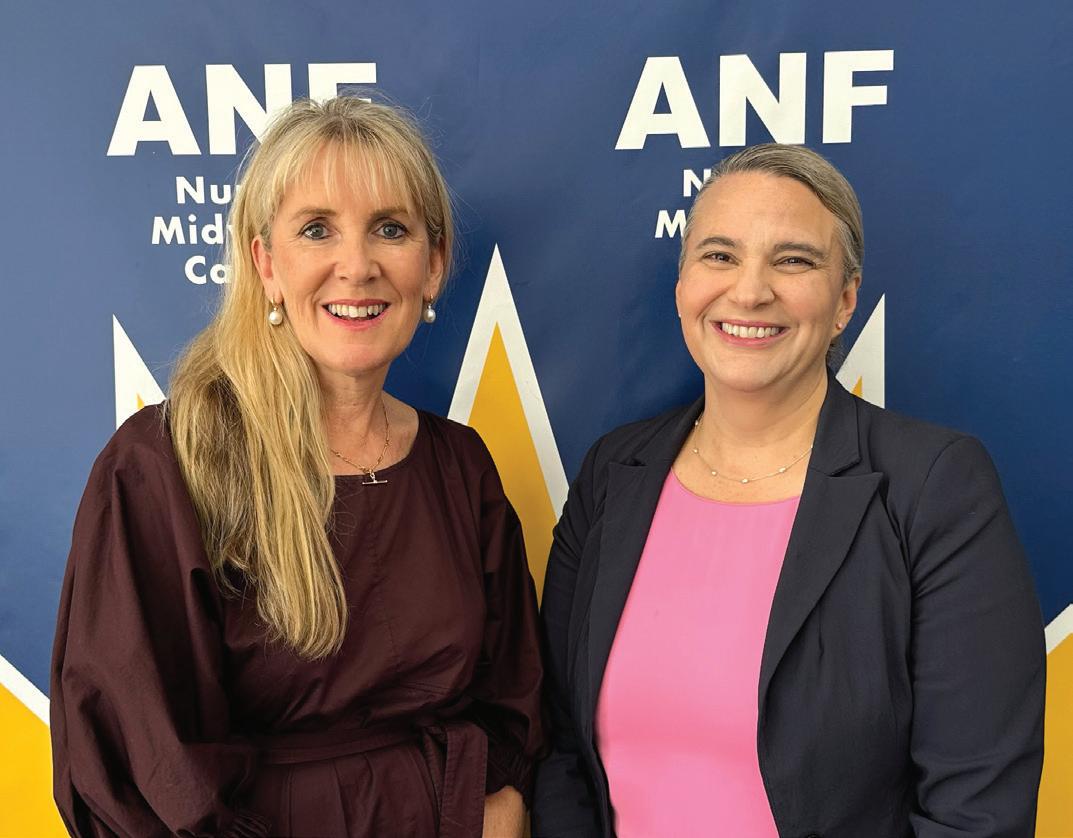
Ms Murphy said Safe Harbour is a necessary tool for nurses and midwives in the current health crisis not only in WA, but nationwide.
“Nurses and midwives make up 55 percent of the healthcare workforce. However, a worldwide shortage has resulted in nurses working in vulnerable settings, work environments which at times are precarious,” Ms Murphy said.
The ANF and the Coroner are calling on the State Government to look into the possibility of introducing Safe Harbour legislation for an Australia-first implementation of what would be revolutionary protections for nurses and midwives to shield them from unnecessary AHPRA investigations as seen after the tragic death of Aishwarya Aswath.
For those who don’t know, Safe Harbour is legislation currently in place in the American states of Texas and New Mexico. The legislation is essentially an added layer of protection for health staff that can be enacted in either written or verbal form to management and executive in dangerous situations.
The legislation is meant to prevent the scapegoating commonly seen for health staff, allowing them another pathway to escalate safety concerns without needing to worry about the possibility of disciplinary action or investigation by AHPRA.
Safe Harbour gives the option for nurses and midwives to either take on the assignment without the fear of being thrown under the bus due to forewarning to superiors through Safe Harbour, or declining the assignment until risk minimisation actions are undertaken by management, without risking disciplinary action.
Safe Harbour is invoked on a good faith basis, and is done in dangerous or hazardous situations such as critical understaffing in the ward or area, a highly unbalanced staffing skill mix or patient acuity being too high for the staff available. The nurse/midwife can invoke Safe Harbour if the usual workplace escalation pathway has been followed with no result.
“We are forced to practice the concepts of triage, allocating the delivery of services based upon most urgent need, rather than gold-practice ideals. Nurses can only provide quality services if their work environments provide adequate conditions.
“The McGowan Government needs to stand beside them. Don’t let them be a scapegoat when things do go wrong. The State Government have a unique opportunity to rebuild the relationship with WA nurses and provide them with a safe harbour when work is indeed not safe. They can lead the way for Australian nurses and provide a recruitment incentive.
“According to nursing theorist Madeleine Leininger, ‘care is the essence of nursing and the central, dominant, and unifying focus of nursing.’ Perhaps Government could show the same commitment to their nurses.”
Most of you reading this will need convincing on the validity and necessity of this legislation. The ANF believe Safe Harbour is necessary and adaptable for the Australian medical system.
With the examples in the US that have existed for over 20 years, applying it to the Australian health system shouldn’t be an insurmountable challenge. As well, it is a vital shield in protection the nurses and midwives in our health system.
ANF State Secretary Janet Reah said the push for Safe Harbour begins now for a better protected future for nurses and midwives.
“I have already written to both the Health Minister and Opposition about this important matter and will be looking at ways we can work with both the State and Federal Governments going into the future on introducing Safe Harbour legislation into Australian law.
“It is vital we move to protect nurses and midwives in order to avoid similar situations such as the Aishwarya case. The ANF will fight to ensure WA does not fall behind when it comes to any legislation that protects our nurses and midwives,” said Ms Reah.
At the start of 2023 the ANF began to implement some major improvements to the ANF Helpline system which were designed to streamline the process of providing industrial advice to ANF members.
The first change was allowing ANF members to book a precise time for their Helpline appointment when an ANF Industrial Officer will call them to provide advice and assistance. The ANF also sends a reminder SMS 15 minutes before the booked Helpline appointment.
The second change was instant call back. That is, if the member does not get to their phone in time when the ANF Industrial Officers calls, the ANF Industrial Officer immediately calls back a second time.
If for some reason the second call is missed, our Industrial Officers will wait 5 minutes and call again. If that third call is missed the ANF calls back again immediately.
The most important thing to remember is ANF Industrial Officers will make that first Helpline call on time.
ANF Secretary Janet Reah, who instigated the changes, thanked those members who provided constructive feedback on how the ANF Helpline service could be improved.
“It will always be important for the ANF to listen carefully to members on the way they want ANF services delivered. These changes reflect my continued commitment and that of the ANF to assist the members’ industrial needs in the best possible way,” Ms Reah said.
The changes mean that members are immediately attended to in their time slot, with easily accessible advice for their industrial needs.
If the case requires ongoing advice, members will immediately be provided an industrial contact, or referred on for matters requiring legal advice or workers compensation advice, if required.
Two questions I have been asked since the unexpected resignation of Premier McGowan are “should Roger Cook be Premier based on his past record in health?” and “should Amber-Jade Sanderson be dropped from the Health portfolio?” My answer to both of those questions are: it’s complicated.
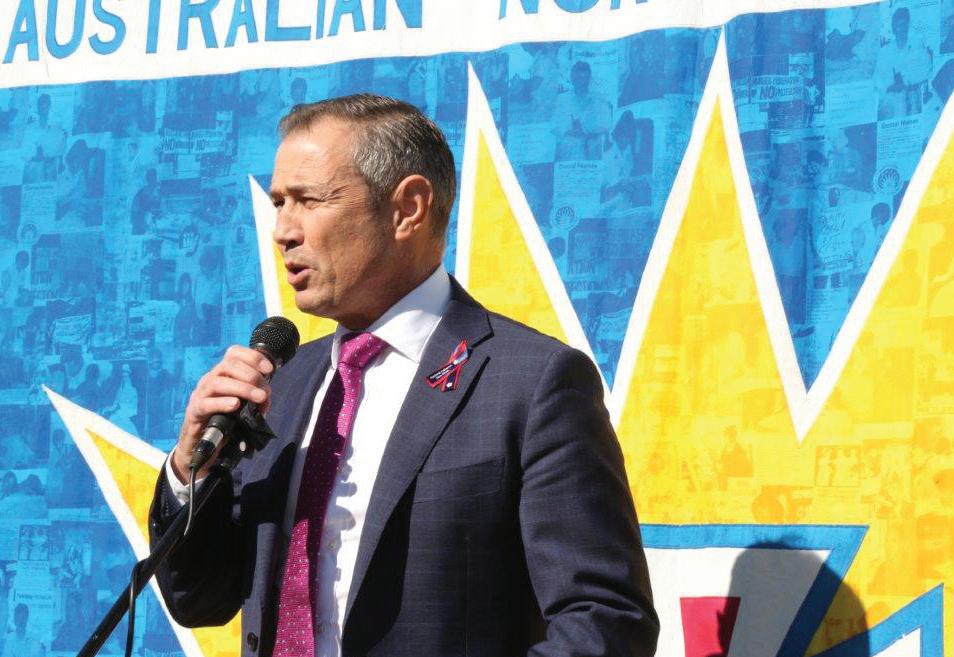
It’s easy to make the argument that neither deserve their respective positions as health has been handled exceedingly poorly by the McGowan Government. After all, this was a Government that was delivered a massive majority in the last state election based on keeping WA safe and healthy during the COVID pandemic. If a minister in any other portfolio was plagued with so much negative media coverage they would have been booted to political oblivion.
But health is a very different area with crippling worldwide worker shortages, increased demand for health services from a rapidly aging population and increasingly complex care need for patients in our hospitals making health arguably the most difficult portfolio for anyone in government to manage. The size and importance
of it is no simple feat, with a Health Minister usually being one of the more busy people in government. Does this excuse bad management of that portfolio? Of course not, but this means anyone put in charge of the health portfolio should be a very switched on, dynamic individual.
That brings us to our main question, how does the WA Government overcome these issues? If it isn’t already obvious and if you haven’t heard me on one of the many occasions speak, it’s primarily about respect and investment in our nurses and midwives. We saw announced a record $1.2 billion dollar investment to health infrastructure with the recent State Budget, but no financial commitment to ensure we have the staff for this infrastructure. WA must have the appropriate incentives to attract nurses and midwives from overseas and interstate. Unfortunately, other states are thoroughly overtaking us. Victoria makes it free to study nursing as well as offer financial incentives and relocation assistance. In Queensland, a nurse is paid $35,000 for relocating there and another $35,000 if they work one year in regional Queensland.
ANF State Secretary has spoken with nurses and midwives across WA about the growing crisis in healthcare.

WA on the other hand has offered to pay $12,000 off a nurses HECS debt for three years of work in a remote or regional public hospital. Along with this, WA nurses are already the second lowest paid in the country. If you were a nurse, which state would you choose to work?

More importantly, if you are nurse or midwife reading this article in the UK, where the WA Government is trying to recruit health staff, which city in Australia would be your point of arrival? Certainly not Perth.
We have heard repeatedly, and incorrectly, from Health Minister Sanderson that the health system is “coping”. When did coping become the new standard for healthcare in WA? We unfortunately see patients and workers in the health system treated nowhere near the level expected of a country like Australia. As well, we have also been told WA does not have a deficit of nurses, midwives and carers. However, the staff at every hospital I’ve visited in the last 8 months tells me the same stories: experienced health professionals are leaving due to impossible workloads, graduate nurses aren’t getting the mentorship they need and are clinical tasks not in their scope. All are overworked and feeling the crush of the cost of living crisis.
For anyone that says health professionals are paid enough or that we have adequate staffing levels either isn’t listening to the
glaringly obvious issues around them or have not themselves been to a hospital in the last decade. WA is seeing an exodus of health workers because they don’t feel respected and are burnt out. If the Cook Government wants to establish itself as a successor to the previous Government, they can’t take the same attitude to the issue. They have neither the time to let this problem fester further, nor the political armour McGowan had.
This Government must have the maturity to admit the problem exists, something the last failed to do. Previous Health Minister Cook and current Health Minister Sanderson were both under orders by McGowan and as with any minister, they are only there to execute the narrative of their leader. What is important now is Premier Cook and Minister Sanderson change that narrative if we are going to lead the nation in health.
The people of Western Australia need Premier Cook’s previous health experience, as well as Minister Sanderson’s more recent experience directed to changing course, applying what they have learned - failures and all. They need to work with the ANF to make the changes desperately needed by our nurses and our midwives including ensuring enforceable patient ratios to manage the workloads and competitive wage outcomes that will make nursing and midwifery in Western Australia attractive again.
“I was so scared to leave a full time role in nursing for the unknown of agency, but it’s been the best thing I’ve done. I have learnt so much and been challenged in multiple ways.”
Of course there are challenges aplenty for any nurse working in more remote areas, as Bec has discovered, but she isn’t going to let that dampen her spirits.
“I miss my friends and family when I am on these contracts and sometimes we don’t have access to the same resources as tertiary hospitals.
“At Meekatharra I work in ED and the general ward, and I also look after five aged care residents with one other nurse on shift. Meekatharra only can do X-Ray scans, and we sometimes don’t even have a doctor on-site so we communicate heavily with EST nurses and doctors for management of patients.”
With all the challenges and changes that come from working in remote areas across the state, by joining the ANF Bec has access to a huge range of support and resources.
The ANF recently celebrated a major milestone, its 40,000th member. This lucky new member, emergency department nurse Bec Gladstone, took some time out of her busy day to speak with the Western Nurse and share her story.
Bec loves to travel and is always looking for her next adventure. This desire to learn and challenge herself, along with her father, is what prompted her to train to become a nurse.
Her first day as a nurse was 12 February 2020, seven years to the day after her father passed away.
“We all know nurses are superstitious, so it had to be a sign it was what I was supposed to be doing with my life,” Bec said.
It was during her father’s treatment that Bec first thought she might want to pursue a career in nursing.
“A huge reason why I went into nursing was because of my lack of knowledge regarding health and the terminology used. I felt like people spoke a different language at times during my father’s treatment. I wanted the knowledge and skills to help others in my situation and be better informed regarding their care.”
Bec has spent most of her career working as an ED nurse, first in a large hospital in Victoria, then in Port Headland through an agency. After a brief stint backpacking and seeking adventure overseas, Bec returned to Western Australia and is now working in Meekatharra on another contract.

She has enjoyed the freedom and flexibility of working through an agency.
“I love to travel while being able to work, and it is amazing to see new parts of the country, learn new culture and meet fellow nurses on similar pathways.
“Obviously, I needed to be covered in my practise and be up to date. So when I joined the ANF in WA it came with lots of access to new learning and updates in practise. I love quizzes as well, and there are many on iFolio.”
With her contract in Meekatharra due to end, Bec has been asking herself what she will do next.
“This role as an agency nurse can take me anywhere. I think I would benefit from doing some more study related to remote nursing and even start directing my career towards the Royal Flying Doctor Service.”
Whatever she chooses to do, Bec can rely on the ANF to support her.
The Australian Health Practitioner Regulation Agency (AHPRA) conducts audits throughout the year, which means that nurses and midwives must ensure they have all their paperwork up-to-date. AHPRA may request evidence of registration, recency of practice, continuing professional development (CPD), and professional indemnity insurance (PII) during an audit.
By using the free online iFolio CPD and advantage of ANF’s audit tool and services, nurses and midwives can not only provide safe and effective care to their patients but also spend less time worrying about their registration obligations.
ANF members can be audited by AHPRA at any time, so it is crucial to stay prepared. The ANF offers the “Audit Without Tears” Legal Talk to its members, which can be conducted in the workplace or via Zoom.
Fortunately, the Australian Nursing Federation (ANF) offers its members free PII as part of their membership and we have already supplied details of our PI Insurance to AHPRA.
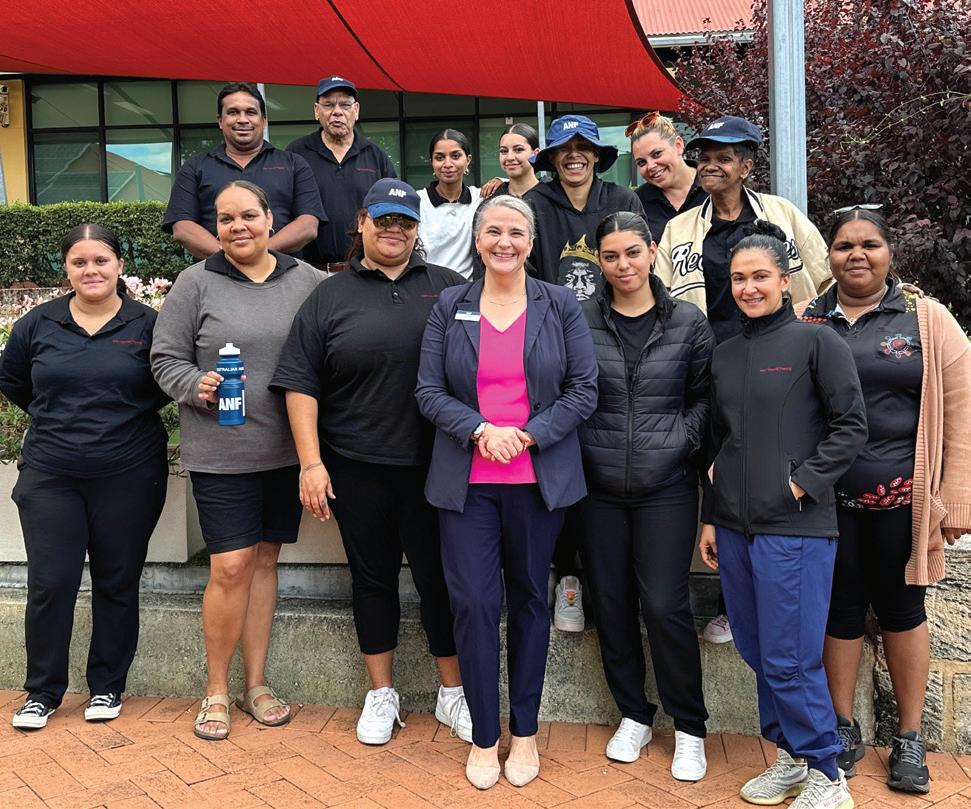
If you want to find out more about the ANF Audit Tool and the iFolio, book into a talk at the ANF Office (which is also available by Zoom), or send a request to ANF Secretary Janet Reah for 30-minute Audit without Tears legal talk in your workplace.
Attending these talks can help members gain valuable insights and stay updated on legal issues affecting their field and are an easy way to add to your yearly CPD.
The current range of topics members can book for a 30-minute ANF talk in the workplace include Coroners Court, Documentation, Social Media, Discrimination, Defamation as well as Audit without Tears.
These topics are relevant to ANF members who are looking to stay informed about legal matters that impact their profession, enhance their continuing professional development (CPD), and meet the expectations set by the Australian Health Practitioner Regulation Agency (AHPRA).
A trip to Kalbarri, from its rugged inland gorges to its dramatic coastal cliffs and sensational beaches, is a Western Australian must do. Nestled at the mouth of the tranquil Murchison River, Kalbarri boasts an ideal climate where a wide range of activities, or a whole lot of relaxing, can be enjoyed all year round.
As the town continues to rebuild and readjust after Cyclone Seroja we reflect on the events of April 2021 when wind gusts over 170km/h left a trail of destruction through Kalbarri and surrounding regions.

In the aftermath of Seroja the ANF provided emergency accommodation to nurses, workers and emergency crews. This included Western Power crews working to restore power to the town.
Cally Meynell has lived in the town since 2018. She has been a nurse for 16 years; working across aged care, palliative care, community nursing, nursing education, emergency department and management. In that time she has worked in metropolitan areas, but she developed a love for rural and remote nursing

She was the Clinical Nurse Manager at the Kalbarri Health Centre when the cyclone struck.
Cally said rural nursing is rewarding, but not without its challenges.
“I love the autonomy of small site nursing and enjoy the challenge. The community connection in a small town allows nurses to feel they are part of the bigger picture and we gain a lot of job satisfaction from the ability to tailor our service to the unique needs of our community,” she said.
The support offered by the ANF included free accommodation as well as general support for town. Without the pressure of looking for accommodation nurses and emergency services could focus on supporting the community.
“Words cannot express my gratitude to the ANF,” Cally said.
“We lost our nursing accommodation during the cyclone and initially, staff slept in swags in offices, loaned rooms and anywhere we could find to put them.
“The ANF was quick to respond when the WA Country Health Service (WACHS) put the call out for help, and within days of the cyclone occurring, we had six emergency accommodation units ready for use.”

Two of the units are still being used as nurse’s quarters today.
In the lead up to the cyclone, Cally was involved in daily meetings with the Local Emergency Management Committee, and Department of Fire and Emergency Services (DFES). The centre did everything to ensure they were prepared.
“Lists of names and addresses of all Commonwealth Home Support Programme (CHSP) clients, and all identified vulnerable local persons were prepared. All local persons on home oxygen were contacted, and extra supplies ordered. Extra oxygen was ordered for the hospital,” Cally said.
A “code red” team of five nurses, one orderly and one doctor were briefed on what to expect. With preparations made, all the team could do was wait.
The Kalbarri Health Centre code red team was locked down in the hospital from 11am the day of the cyclone, 11 April, until midday the following day.
The Health Centre lost landline and internet communications early on. Mobile communications were lost about halfway through the cyclone.
“Streetlights and town power were lost. Objects such as roofing materials could be seen passing through the carpark. The noise was unimaginable.”
At one point staff heard a loud crash and the sound of tearing. It was obvious the Health Centre had been damaged, but it was only after the cyclone passed the team discovered a large piece of roofing tin come through roof and ceiling in a back corridor. This damage would prove minor in comparison to what was suffered by others.
Once the storm passed the team was left waiting for casualties to arrive at the Health Centre. The team had prepared for everything from minor injuries to major trauma.
“The night was long, and we slept little and in shifts – no casualties came – and for this we will forever be amazed and incredibly grateful.”
Even so, staff remained incredibly busy. Many homes had lost power, so Health Centre staff heated meals and delivered them to vulnerable people around the town. Two days later the WA Medical Assistance Team arrived, closely followed by nurses and support staff arranged by the WACHS Emergency Operations Centre.
“These extra hands both assisted with the workload and allowed staff to take a break to manage their own property loss. WACHS arranged support for us from the psychological first aid team. As a team we felt supported by our organisation,” Cally said.
There were a lot of tears after the cyclone. People has lost homes and businesses and the local school was closed. But, as small towns tend to do in the wake of a disaster, the community pulled together to rebuild.
Steve McKenzie has lived in Kalbarri for 27 years and runs a commercial laundry and public laundromat. He said the support given by the ANF was invaluable. Steve considers himself very lucky.
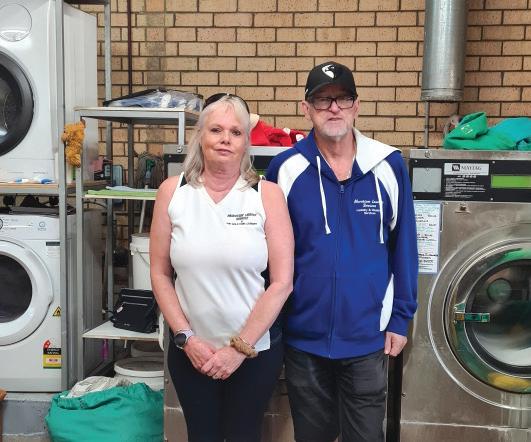
“We were lucky with the house,” Steve said.
“There was only had a little bit of damage outside, including a limestone wall that was blown over. We were lucky with the laundry too. We lost power, but there was minimal damage.”
With no power the business could not open, but fortunately he got a call from the ANF offering the use of some generators.
“With the power back up we could start washing. People without power in their homes could come and wash their clothes.”
It wasn’t just local people either, it was the SES and DFES and others who had come to the area to help. Steve was able to keep the laundromat and commercial laundry open until the power came back on about 20 days later. Because of the ANF generators, they were only been offline for about two days.
“It was a massive help,” Steve said.
“The ANF did a lot to help Kalbarri. They put a lot into the community that many people didn’t know about.”
The Western Australian qualification allowance for nurses and midwives is a crucial provision to ensure those working in the industry are able to access training and education, by offering financial support for those looking to improve their qualifications.
Despite the many benefits to nurses, midwives, WA Health and the WA community more broadly, the government dropped the qualification allowance in the 1990s along with a range of other conditions.
In the 2001 EBA campaign, it was put back on the agenda when the ANF secured a one off payment of $1500 payment to support nurses or midwives who had a post graduate certificate.

The ANF was not satisfied with the one-off payment and continued its campaign for improvements in the qualification allowance and during the 2007 EBA campaign, the one off payment was replaced by the fortnightly payment we have today. In addition the ANF introduced a new three tier system based on three levels of qualification: a certificate qualification; a diploma or Degree/ Bachelors; or a Masters or Doctorate qualification.
The ANF knew that from time to time there would be debates about who was entitled to receive the allowance and insisted on the creation of an Independent Review Panel (IRP) to act as an appeal process for applications initially refused by the local health service.
One might think there would be consistent government support for a program that delivers additional skills and qualifications to the nursing and midwifery workforce as well as retaining experienced staff but the history of the current ANF qualification allowance is one of a hard fought battle by the ANF since 2001 to obtain and protect an allowance that was lost in the 1990s.
Not long after the 2007 EBA concluded the ANF took the initiative and published a list of qualifications to be included in the allowance to provide some guidance to members and that list formed the basis of the qualifications list that is used by the health system today.
The IRP comprised three panel members; one from WA Health, one representing the Chief Nursing Officer (CNO), and one from the ANF.
Outgoing ANF panel member nurse Michael Clancy has been privy to the inner workings of the IRP for over 10 year says the fight to keep the system fair and supporting both nurses and midwives gets tougher each year and describes it as a painful process just to get a fair result for ANF members who lodge appeals.
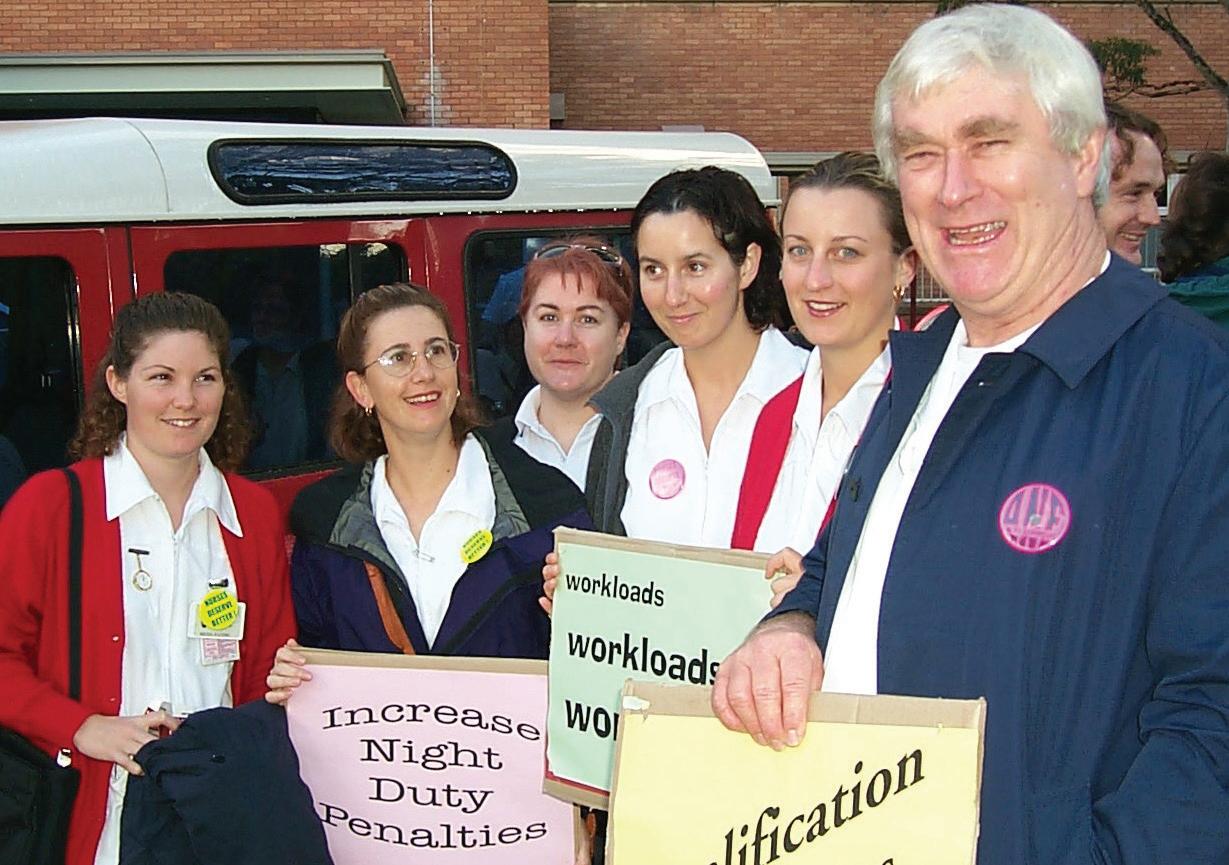
In the early years the Office of Chief Nurse and Midwife (CNMO) was semi-independent and qualifications were approved on their merit however in recent years the CNMO has become more influenced by WA Health and it has become an unequal battle for the ANF who only has one representative on the three person panel.
The number of appeals has increased each year.
Michael says there were only two meetings a year but as he hands the job over to Janet Reah it is now four to six meetings each year.
The qualification allowance is an incredibly important resource for nurses and midwives, a resource that Mr Clancy says also supports employers and patients.
“The allowance means we are creating a more highly skilled workforce, which helps everyone.”
The importance of the ANF role to ensure the qualification allowance is not eroded was made abundantly clear in 2016 when the Office of the Chief Nurse secretly removed 50 midwifery qualifications. The reasoning behind this decision was that midwifery was a separate profession to nursing and the midwifery qualification was considered as an entry level qualification, and therefore not covered by the allowance.
The ANF State Secretary had to contact the WA Health Minister directly to argue the case to retain the removed qualifications and in the end the qualifications were reinstated and the ANF successfully fought to obtain the back pay.
As a direct consequence of these actions the ANF insisted on a new clause to be added to the EBA so that no qualifications on the published list could be removed without agreement from the ANF.
ANF Secretary, Janet Reah, who takes over as the ANF representative on the panel says the risk of qualifications being removed it is still very real and WA Health and the CNO still disagree with the ANF in regards to the inclusion of courses, including the Bachelor of
Midwifery. There are more qualifications the ANF strongly believe should be recognised, but the organisation is outvoted by the other two panellists from WA Health and the CNO.
This is not the only time support for nurses and midwives had been at risk. Recently there was a move to bring the allowance in line with the Australian Qualifications Framework, but only “Level 8” qualifications would be approved. This would again mean limited support for midwives.
Prior to this, some qualified professionals from the UK were disqualified from the allowance despite being recruited to work in Australian intensive care units, emergency departments and other vital areas.
“It has and will continue to be a constant battle to protect this allowance” Janet said.
Under the current agreement, registered nurses and midwives who meet a range of criteria may be eligible for the qualification allowance for an approved list of courses. The payment of the allowance is fortnightly and calculated as a percentage of income for the level 1:8 nurse or midwife. If a course is not included on the list, it will need to go to the Independent Review Panel for review.
Read this article and complete the quiz to earn 1 iFolio hour
Palliative care is treatment, care, and support for people with a life-limiting illness.1,2 It is patient-centred care that aims to optimise the quality of life of the patient and their family. 1 Palliative care may involve managing physical symptoms, as well as emotional, spiritual, psychological, and social support.2 End of life care is an important part of palliative care.1 It is the increased care and services given in the last period of the patient’s life as they are rapidly approaching death.1,2
Many people, due to illness or old age, require responsive care as they approach death.2 Palliative care may be provided in a range of settings including the patient’s home, hospital, or a residential aged care facility.1,2

Reduced oral nutrition and hydration is common for patients at the end of life.3,4 This may be due to illness or treatmentrelated symptoms, generalised weakness, a decreased level of consciousness, or a loss of desire to eat and drink. 3
Care at the end of life, including nutrition and hydration, should be responsive to the individual needs and preferences of the person who is dying.5 The care planning process should include discussions with the patient and their family about current and anticipated nutrition and hydration care needs, and cultural, religious, and social preferences.1,5 The nutrition and hydration care plan should take into account the patient’s prognosis and the severity of any oral intake problems in line with their care goals and preferences.2,6 Decisions regarding nutrition and hydration should be patient-centred, individualised, and open to change as the patient’s condition changes.6
Loss of appetite (anorexia) and weight loss (cachexia) are significant problems for many palliative care patients.4 Loss of appetite and weight loss are independent predicters of a poorer prognosis.4
Palliative conditions commonly associated with loss of appetite and weight loss include end-stage respiratory failure, end-stage cardiac failure, chronic liver disease, chronic renal failure, HIV/AIDS, progressive malignancy, and advanced dementia.4
Loss of appetite
Appetite and loss of appetite are subjective.4 Symptoms of loss of appetite include:7
• Not feeling hungry
• Having no interest in food
• Experiencing changes in the taste and smell of food
• Feeling full after eating a small amount. Factors that may contribute to loss of appetite at the end of life include:4,7
• Mouth problems, such as mucositis, gum disease, oral thrush, and dry mouth
• Nausea and vomiting
• Constipation
• Pain
• Metabolic changes
• Dysphagia (difficulty swallowing)
• Dyspnoea (difficulty breathing)
• Dysgeusia (changed sense of taste and smell)
• Depression, anxiety, and stress
• Weakness and fatigue
• Decreased level of consciousness
• Reduced level of physical activity
• Effects of medications.
Other factors that may contribute to loss of appetite include inappropriate food presentation, and family, social, and cultural expectations regarding food, diet, and body weight.4
Reversible contributors to appetite problems should be identified and appropriately treated.4,7 Loss of appetite may also be treated with medications, such as progestogens and corticosteroids, to stimulate appetite. 8 However, the general basis for managing loss of appetite in palliative care is accepting that it is due to the patient’s condition, and the main principle of patient management is focussing on food as a way of promoting quality of life.1,9 It is better for patients to eat something small and pleasurable than to struggle to eat something for ‘proper nutrition’.9
A decline in nutrition may manifest as progressive weight loss.4 Weight loss may also be associated with disease progression or treatments, sometimes with no associated loss of appetite or decreased food consumption.4
A focus on nutrition for weight gain may not result in meaningful clinical changes for palliative patients.4 Weight gain on its own may or may not improve quality of life for palliative patients.4
Cachexia anorexia syndrome is a
complicated metabolic syndrome related to an underlying illness, such as cancer, chronic heart failure, and end-stage renal failure.10 Cachexia anorexia syndrome is characterised by weight loss, with or without fat loss, and at least three of the following symptoms:10
• Loss of appetite
• Reduced muscle mass
• Decreased muscle strength
• Fatigue
• Biochemical alterations, such as anaemia, inflammation, and low albumin.
As patients approach death the desire to consume fluid can diminish.3,5 Reduced fluid intake is generally part of the normal process of the body shutting down and is part in the natural cycle of changes that occur at the end of life. 3
Signs of dehydration include dry mouth, thirst, confusion, agitation, delirium, and decreased levels of consciousness.3,5
Factors that may contribute to dehydration at the end of life include:3,5
• Vomiting
• Diarrhoea
• Dysphagia
• Generalised weakness
• Decreased level of consciousness
• Loss of desire to drink
• Effects of medications, such as diuretics.
The hydration status of patients at the end of life should be assessed at least daily.5 More frequent assessment may be needed for some patients as their condition can change quickly.5 Hydration assessment includes consideration of objective and subjective measures, such as skin turgor, evidence of peripheral oedema or pulmonary congestion, and hydration of oral mucosa.5
Ongoing assessment facilitates the rapid identification of concerns with hydration status, problems with oral hydration, and any need for medically assisted hydration.5 Some palliative care patients who want to drink may be unable to and may need support to drink or may benefit from medically assisted hydration.5 However, drinking may be associated with swallowing problems and a risk of aspiration, and excessive assisted hydration may be associated with swelling and breathing difficulties. 5
The risks and benefits of hydration options at end of life should be carefully considered in line with the patient’s care goals and
preferences.2,5 It should also be noted that dehydration is associated with some beneficial effects; it reduces secretions, improves respiratory congestion, decreases gastrointestinal secretions and oedema, and acts as a natural anaesthetic that may reduce suffering. 11
The general principle for managing dehydration at the end of life is focusing on patient comfort and quality of life. 5 Reversible contributors to hydration problems should be identified and appropriately treated.3,5 Manageable symptoms of dehydration, such as dry mouth, should also be treated to improve patient comfort.3,5
Nutrition and hydration at the end of life may create ethical dilemmas for clinicians, patients, and families.1
There may be a point when nutrition and hydration can only be maintained by medically assisted nutrition and hydration.1,11 However, the evidence regarding medically assisted nutrition and hydration at the end of life is limited, and is the subject of ongoing ethical debate.3,6
Medically assisted nutrition and hydration is perceived by some as providing comfort, improving quality of life, and offering a minimum standard of care.11 In contrast, others believe medically assisted nutrition and hydration is a painful and intensive therapy that is unnecessary and limits the acceptance of a terminal condition.11 Medically assisted nutrition and hydration is generally not recommended for patients at the end of life as it does not prolong survival or significantly improve quality of life.11
It is recognised that medically assisted nutrition and hydration a may provide emotional support and comfort to some patients and families.11 Family members are often concerned that the patient will experience distress associated with hunger and thirst, and decisions to not provide medically assisted nutrition and hydration may be perceived as ‘giving up’.1,11 Decisions regarding medically assisted nutrition and hydration should be made in accordance with the primary goal of palliative care, that is patient comfort and quality of life.1,11
Discussions about the impact of disease progression and ageing should take place with the patient and their family at the earliest opportunity to allow them to
make informed decisions about goals and preferences for care.1 Early and ongoing discussions help patients and families understand the trajectory of the patient’s condition, and consider the benefits and limitations of nutrition and hydration support at the end of life. 1
1. The Royal Australian College of General practitioners (RACGP). RACGP aged care clinical guide (silver book) [Internet]. 5th ed. East Melbourne: RACGP; 2019 [cited 2021 Feb 24]. Available from: https://www.racgp. org.au/silverbook
2. Australian Government Department of Health. Palliative care [Internet]. 2019 [cited 2021 Mar 8]. Available from: https://www. health.gov.au/health-topics/palliative-care/ about-palliative-care/what-is-palliative-care
3. Lokker ME, van der Heide A, Oldenmenger WH, van der Rijt CC, van Zuylen L. Hydration and symptoms in the last days of life. BMJ Support Palliat Care [Internet]. 2019 [cited 2021 Mar 2]. doi: 10.1136/ bmjspcare-2018-001729
4. CareSearch. Clinical Evidence [Internet]. Appetite problems; 2019 [cited 2021 Jan 4]. Available from: https://www.caresearch.com. au/caresearch/tabid/182/Default.aspx
5. National Institute for Health and Care Excellence (NICE). Care of dying adults in the last days of life [Internet]. London: NICE; 2017 [cited 2021 Mar 14]. Available from: https://www.nice.org.uk/guidance/qs144/ resources/care-of-dying-adults-in-the-lastdays-of-life-pdf-75545479508677
6. Spiro A. Nursing in Practice [Internet]. Nutritional management in palliative care; 2018 [cited 2021 Mar 9]. Available from: https://www.nursinginpractice.com/clinical/ nutritional-management-in-palliative-care
7. Health Navigator New Zealand. Health A-Z [Internet]. Appetite loss in palliative care; 2020 [cited 2021 Mar 10]. Available from: https://www.healthnavigator.org.nz/ health-a-z/p/palliative-care/palliative-careappetite-loss
8. CareSearch. Clinical Evidence [Internet]. Appetite stimulants; 2019 [cited 2021 Mar 4]. Available from: https://www.caresearch. com.au/caresearch/tabid/184/Default.aspx
9. PalliativeCare Victoria. Anorexia in Advanced Illness [Internet]. Melbourne: PalliativeCare Victoria; 2015 [cited 2021 Mar 8]. Available from: https://w6p3u3w8.stackpathcdn.com/ wp-content/uploads/2019/03/Anorexia-inIllness.pdf
10.CareSearch. Clinical Evidence [Internet]. Cachexia anorexia syndrome; 2019 [cited 2021 Mar 4]. Available from: https://www. caresearch.com.au/caresearch/tabid/183/ Default.aspx
11.palliAGED. Evidence Summaries [Internet]. Nutrition – Synthesis; 2017 [cited 2021 Jan 4]. Available from: https://www.palliaged. com.au/tabid/4329/Default.aspx
The Western Australian Government will receive $11.7 million in Federal funding as part of a pilot program which aims to support nurse practitioners and patients.
ANF State Secretary Janet Reah said the program is a positive and long overdue initiative that will help address the difficulties experienced by the community in accessing free health care and will assist people to avoid visits to emergency departments.
“This program is a great opportunity to enhance primary care access to patients,” Ms Reah said.
“It is good to see any degree of support from the Federal Government to help expand the skillset of nurses and alleviate pressure in our emergency departments.
“If the pilot program is a success, opportunities for expansion should definitely be investigated to include greater numbers of nurses across the state as well as including midwives in the program.”
The Nurse Practitioner and Team Based Care Pilot program will fund 20 nurse practitioners over two years to diagnose and treat a range of health conditions. Their services will be free to patients.
The pilot aims to improve patient access in underserviced and vulnerable populations and to help address health workforce shortages in WA.
Federal Minister for Health and Aged Care Mark Butler said the pilot “is a nationleading opportunity for nurse practitioners to work to their full scope of practice leading to better health access for Western Australians.”
Nurse practitioners engaged through the pilot will be based in primary care services throughout WA. The precise locations will be subject to an EOI process.
With record numbers of Australians working multiple jobs or supplementing their income, the Australian Taxation Office (ATO) is reminding taxpayers to consider if they are “in business” and to declare all income when lodging their tax return.
ATO Assistant Commissioner Tim Loh said if you earn money through continuous and repeated activities for the purpose of making a profit, then it is likely you’re running a business.
“While there are always new and different ways to make money, the tax obligations remain the same. Don’t fall into the trap of forgetting to include all your income thinking the ATO won’t notice,” Mr Loh said.
“With tax time just around the corner, if you are bolstering your income with new activities, make sure all your records are up-to-scratch.”
“It doesn’t matter whether you are carrying on a business or simply earning additional income through a digital platform, such as a website or even an app, you must keep accurate records of your income and include it in your tax return.”
According to the ATO, businesses have a range of obligations depending on their structure and turnover, including registering for an Australian business number, keeping the right records and lodging the right type of tax return. They may also have to register for goods and services tax.
“Sometimes it’s hard to tell if you’re ‘in business’ and we recognise not everything you do to make money is considered a business,” Mr Loh said.
“The ATO won’t consider activities as ‘in business’ when they are a one-off transaction (unless it is the first step in carrying on a business or intended to be repeated) or an activity from which you don’t seek to make a profit.”
The ATO has new to business resources at www.ato.gov.au/Business/Starting-yourown-business
According to statistics released by the Australian Bureau of Statistics (ABS) the population of Australia’s capital cities grew by 205,400 people in 2021-22, following an overall decline in the previous year.
ABS head of demography Beidar Cho said the population of Australia’s capital cities fell by 47,300 people in 2020-21, due to COVID-19 related changes to migration patterns.
“Before this, the combined capital city population increased by 217,000 in 201920 and 277,400 in 2018-19,” Ms Cho said.
In 2021-22 Brisbane’s population increased by 59,200 and Melbourne grew by 55,000, with Sydney and Perth each increasing by more than 30,000 people.
Brisbane also had the highest growth rate, growing by 2.3 percent, followed by Perth with 1.5 percent and Adelaide by 1.1 percent.
As well as the combined growth of 205,400 in capital cities, growth in regional areas was also strong, up by 102,700 people. This represents 1.2 percent growth in both cities and regional areas.
The Australian Digital Health Agency launched a new mobile app, my heath, to allow patients more convenient access to their My Health Record.
Those who use the new app will be able to see medicine information history, check pathology results, view their vaccination history, view hospital discharge summaries, keep track of advance care planning documents, share their documents with others and track information on allergies or reactions.
Users will also be able to view multiple records, such as records for children under 14 and any other records with authorised access.
The decision to create the app followed a reported 292 percent increase in consumer views of My Health Record in the past financial year. my health is now available to download for iOS and Android from the Apple Store of Google Play.
The Australian Taxation Office (ATO) is urging Australians to double-check their super accounts following the release of new data showing $16 billion in lost and unclaimed super across the country. According to the ATO, this represents a $2.1 billion increase since the last financial year. However, it is not all bad news as ATO Deputy Commissioner Emma Rosenzweig has said finding lost or unclaimed super is easy and can be done in a matter of minutes.
“People often lose contact with their super funds when they change jobs, move house, or simply forget to update their details,” Ms Rosenzweig said.
“This doesn’t mean your super is lost forever – far from it. By accessing ATO online services through myGov, you can easily find your lost or unclaimed super.”
The ATO explains that super is considered "lost super" when it is still held by the fund but the member is uncontactable or the account is inactive. Super funds currently hold $10.4 billion in lost super, with a further $5.6 billion in super also held by the ATO itself.
For information on how to manage your super and view all your super accounts, including lost and unclaimed super, visit ato.gov.au/checkyoursuper
The House of Representative’s Standing Committee on Health, Aged Care and Sport report has made nine recommendations regarding long COVID and repeated COVID infections, including the establishment of a national long COVID and COVID-19 database.
A statement released by the Australian Parliament said the report aimed to improve Australia’s response to long COVID, an often-debilitating condition possibly affecting hundreds of thousands of Australians.
The Chair of the Committee, Dr Mike Freelander MP said the emergence of long COVID has created challenges for patients and health care professionals alike.
“People with long COVID suffer from a lack of information and treatment options,” Dr Freelander said.
“Health care professionals, who worked tirelessly over the acute phase of the pandemic, are now in a difficult situation trying to support patients with this new and poorly understood condition.”
The recommendations made by the Committee included:
• A definition of long COVID for use in Australia
• Evidence-based living guidelines for long COVID, co-designed with patients with lived experience
• A nationally coordinated research program for long COVID and COVID-19
• The COVID-19 vaccination communication strategy
• Access to antiviral treatments for COVID-19
• Support for primary healthcare providers
• Indoor air quality and ventilation.
Over the course of the inquiry, the Committee held four public hearings and received almost 600 submissions from individuals, organisations and government bodies.
Housing costs across Australia are adding further pressure to the lives and incomes of essential workers, including nurses and aged care workers.

A new report by Everybody’s Home, a national campaign to fix the housing crisis, has found increasing rents are effectively pricing essential workers out of being able to afford living in their own communities.
On a national level the report found the average employee spends around two thirds of their income on housing. The story is, unfortunately, very similar for nurses and aged care workers in WA.
Broken down by region, an aged care worker in Central Coast was likely to spend 40 percent of their income on rent, with 60 percent for the South West and the Goldfield regions. In Perth however the situation was much worse with 69 percent of income spend on rent, with an aged care worker in Northern WA likely to spend a whopping 77 percent of their income on rent.
WA Nurses were better off by a few percentage points, with the percentage of income spent on rent as follows: Central Coast, 37 percent; South West WA, 55 percent; the Goldfields region, 55 percent; Perth, 63 percent; and Northern WA, 77 percent.
Households or individuals spending more than 30 percent of their income on rent are widely considered to be under rental stress.
Everybody’s Home spokesperson Maiy Azize said virtually no region of Australia is affordable for aged care workers, early childhood carers, cleaners, nurses, and many others that our communities rely on.
“Essential workers are the backbone of our communities, yet they are being priced out of them because of the unsustainable rises in rents. More and more essential workers are being pushed into serious rental stress.”
One in five community health service workers are considering leaving the sector in the wake of the COVID-19 pandemic, with a reported increase in stress levels and staff burnout.
This sobering news comes after a longitudinal study by Deakin University’s Institute for Health Transformation (IHT) and the Victorian Healthcare Association, which found community health service workers experienced considerable psychological distress during the pandemic. IHT senior research fellow Dr Sara Holton, said the results of the study were a wakeup call.
“Community health services provide government funded primary care to hundreds of thousands of mostly vulnerable people each year, including GP, dentistry and allied health services,” Dr Holton said.
“During the pandemic, they continued to provide care for their clients as well as playing a central role in the pandemic public health response.
“These findings reveal the need for additional staffing and resources, greater managerial and IT assistance for remote working and additional psychological support to protect their well-being, support them to stay in their roles and continue to provide essential services for their clients.”
According to the survey, one in five community healthcare workers were thinking of leaving in the sector as a result of heavy workloads and stress.
“Losing these workers from the sector presents a real risk to the often-vulnerable communities they serve,” Dr Holton said.
Bridie Rogan is a Clinical Nurse working at Bandyup Women’s Prison for over 20 years.
While working in the public hospital system, Bridie was contacted by a friend who was nursing at Bandyup Women’s Prison and asked to help due to staff shortages.

“Initially whilst apprehensive, believing it would be difficult and dangerous, I agreed to help.” Ms Rogan said.
as airport screening, collect keys, radio, and personal duress alarm (PDA) prior to proceeding to the health centre.
The keys allow access through most grilles/doors and must be securely attached to a belt and hidden from view. Staff are also required to always carry a radio as it’s an important mode of communication, particularly for emergencies. Likewise, PDA must also be attached securely on person and activated in real or imminent dangers.
Safeguards are in place in the event a prisoner’s behaviour is escalating in a threatening manner or in any volatile situation where nurses may have concern for their safety, they can press their personal duress alarm and the Custodial Response Team will attend immediately.
Ms Rogan said that despite her belief working as a prison nurse would be dangerous, she found the opposite to be true.
“In reality it’s probably safer than working in our EDs as we have custodial officers with us at all times.”
At Bandyup, security rules are of utmost importance and strictly adhered to. When arriving at the prison at the beginning of a shift, staff are required go through the same security screen unit
“Regardless of how safe we feel we must maintain awareness of potential risks and ensure any clinical tools that could be taken and used for other inappropriate purposes or a weapon aren’t left lying around must be secure at all times. It’s an awareness you need to add that isn’t usually seen in a normal hospital.”
Ms Rogan said that while prisons primarily provide custodial services for incarcerated people, health care provides a significantly important role within the prison system.
“I did some casual shifts and discovered it to be very interesting, diverse and challenging and soon came to enjoy this type of nursing. I succeeded in obtaining a permanent contract and 20 years later I’m still there.”(left to right) Michelle White CN, Janet Reah ANF State Secretary, Yvonne Morris CN, Bridie Rogan CN.
People entering the prison system can come from a wide variety of backgrounds and life experiences. Many have not previously had access to essential health care in their community thus contributing to often poor and chronic physical health, as well as mental health issues.
“We receive high numbers with comorbidity risks and large numbers of prisoners who may have been homeless, with a background of drug/alcohol addiction and sexual/physical abuse.
“They may have limited education hence the importance of our health promotion/education activities to enable informed decisions and self-reliance, including success with routine screening and immunisations to a group who may otherwise not access health services.”
The women’s prisons frequently have pregnant women and they attend KEMH for their antenatal care. After giving birth, mothers are allowed bring their baby back to Bandyup where they are housed in the mother and baby unit for a specified amount of time.
Ms Rogan also highlighted the intricacies of shift work at Bandyup, as well as arrangements for treating patients.
“Our shifts include a combination of 12, 10 and 8 hour shifts with some metropolitan prisons providing 24-hour nursing care.
“The 12 and 10 hour day shifts begins at 7am with handover from the nurse on the previous night shift and if lucky grab a quick cup of tea before going out to the different units to administer morning insulin and medications .This may take up to an hour to complete.”
Nurse-led clinics are run throughout the day where inmates have pre-scheduled appointments for various assessments and treatments such as: wound dressings, ECG’s, immunisations, phlebotomy, BBV screening/treatments, diabetes, cardiac or respiratory disease management, and any other health issues requiring nursing care.
Throughout the day there may be acute walk-ins and the nurses are required to attend to all “code reds”, the code for emergencies in prisons, which may be for inmates experiencing chest pains, respiratory issues, seizures, sport and other injuries, or self-harm incidents.
Prison health services can be similar to remote health clinics and mini emergency departments with general and mental health nurses on duty.
The challenges of the past few years have again demonstrated the indispensable role nurses and midwives play in protecting the Western Australian community. We believe this ceaseless contribution to the wellbeing of others is worth celebrating.
For over 20 years the Western Nurse has taken great pride in sharing the stories of our incredible members, from Registered Nurses, Enrolled Nurses, Midwives, Assistants in Nursing and students. We want to continue sharing these stories. We want to hear from you, our members.
Bandyup inmates have access to doctors, psychiatrists, dentists and other allied health on specific days and also a 24 hour oncall doctor whom can be e-consulted if needed. For emergency events, patients are sent out to an ED for urgent treatments.
Ms Rogan pointed out that while Bandyup offers great health services for their female inmates, there are challenges that come with patients confined to prisons.
“Weight gain/obesity is one issue we do see, often due to boredom or comfort eating or lack of exercise which contributes to health issues such as diabetes or cardiac problems. As well, you can see drug seeking behaviour when inmates come to prison initially due to previous addiction issues.”
However, Ms Rogan said the most satisfying part of her job is being able to track the improvement of patients in the prison system.
Hospitals usually have a quicker turnover, while in prisons there are more constant patients over a longer period. This provides more time to treat them over a period of time and work with their health conditions and achieve improvement.
"We have doctors and other allied health attending clinics on specific days of the week and Bandyup provided 24 hour nursing cover. Prison nurses have a lot of autonomy and the ability to make a difference with healthcare and contributing to the health of these people who come to us with a lot of chronic conditions. We have great colleagues, great teamwork and develop great relationships," Ms Rogan said.
“Prison nursing is a pivotal role. It can be challenging but mostly very rewarding and very different from the role of nursing in other healthcare facilities. We rarely feel unsafe as we have custodial officers located in the health centre throughout the day and escorting us when attending the units or other areas throughout the prison.”
If you have a story to share about your profession, current practices or research, milestones you have reached or achievements and awards received by you or your team then we encourage you to get in touch.
Stories can be sent to Western.Nurse@anfiuwp. org.au and should be no longer than 200 words. We also encourage you to send through photos.
You can also send through any questions you have about the Western Nurse publication.
We hope to hear from you soon.
The Western Nurse.
“The most rewarding is the transition of patients who may have drug, alcohol and health issues. We see them go through the transition of recovering and now working and being more health orientated as well, which proves to be a challenging yet very rewarding achievement.”
A report by psychologists at UNSW Sydney and Western Sydney University has found self-destructive behaviour may be caused less by personal unwillingness to change, but rather a learning issue where people create logical but incorrect links for why they are suffering.
The report, published in the Proceedings of the National Academy of Sciences journal, says misunderstanding the links between actions and consequences could be what makes giving up harmful habits so difficult.
Central to the study was an experiment where volunteers played a video game about intergalactic space trade. Participants clicked on two planets to get points, with the possibility of winning money.
Clicking either planet led to a similar reward, clicking one planet caused a pirate ship that would steal points.
Some people, who the researchers deemed the “sensitives”, quickly understood the link between choosing the “bad” planet and the pirate ship and adjusted their behaviour. However, after a few rounds a significant number of people had failed to see the link between choosing the bad planet and the emergence of the pirate ship.
At this point, the researchers explained the connection to participants, showing them the link between selecting the bad planet and the negative outcome.
Amazingly, even with this new information, a proportion of participants continued to choose the planet that gave the negative result.
“We already know from previous studies using the same video game that many people, who we call ‘unawares’, fail to realise how their actions lead to negative outcomes,” lead author Dr Philip Jean-Richard-dit-Bressel said.
“In our recent experiment where we revealed to the ‘unawares’ how their choices are leading to negative outcomes, most quickly changed their behaviour and started acting in ways that were beneficial to them. But there was still a subset of individuals that continued with their previous detrimental behavioural pattern, who we called ‘compulsives’.”
Study co-author Professor Gavan McNally said the research highlights new ideas about what is going on at the cognitive level.
“Up until now self-destructive behaviours that are difficult to shift are commonly attributed to two explanations,” Dr McNally said.
“One is that the individual simply values what they’re pursuing above all else – such in the case of drug, alcohol or gambling addiction. Or the other explanation is that their compulsions are occurring outside their control or awareness.
“What we show is there is a cognitive pathway that emerges not from differences in value or awareness, but from failing to understand or appreciate correctly that their own actions are leading them to harm. Our ‘compulsives’ are indeed learning, it’s just that they learn the wrong thing.”
The researchers are planning to progress the research further to find out why certain people may find it harder to learn from their mistakes, as well as tailoring therapy to the individual.
While muffins have been described as tasty, delicious, moreish or even scrumptious, they are seldom described as healthy. This may all be about to change with recent developments in muffin-related science undertaken by the Norwegian University of Science and Technology (NTNU) and Amity University in India.

Researchers developed a new type of muffin, which they named “Roselle” after the common name for Hibiscus sabdariffa. The new super muffin contains calyx extract taken from this tropical plant.
Calyx extract contains bioactive compounds such as polyphenols, flavonoids, betaine and hibiscus acid, which all have positive health effects and may reduce the risk of chronic disease. These preservative free muffins also store well, remaining fresh for up to six days at room temperature. While all of this seems like good news, researchers admit the primary beneficiaries of this research are people who already eat muffins.
Study co-author and associate professor at NTNU’s Department of Biotechnology and Food Science Eva Falch doubts Roselle would be classified as healthy in Norway.
“In food cultures where baked goods like this are part of the daily diet, Roselle muffins can contribute to increased nutritional value. To make a healthy version, the whole composition should be as good as possible, with little sugar, salt, saturated fat, and so on,” Ms Falch said.
So while this is a positive step towards muffins being a part of healthy diet, the next steps would be to test this ingredient in products with a better nutritional profile, such as whole grain products.
Silicon, gold, copper and electricity among new weapons against COVID-19
New research from Curtin University has found that silicon, gold, copper and electrical currents may have a part to play in reducing the spread of COVID-19.
Lead researcher Dr Nadim Darwish from the School of Molecular and Life Sciences at Curtin University said the study found coronaviruses “spike proteins” can stick to certain surfaces.

“Coronaviruses have spike proteins on their periphery that allow them to penetrate host cells and cause infection and we have found these proteins become stuck to the surface of silicon, gold and copper,” Dr Darwish said.
“We believe these materials can be used to capture coronaviruses by being used in air filters, as a coating for benches, tables and walls or in the fabric of wipe cloths and face masks. By capturing coronaviruses we would be preventing them from reaching and infecting more people.”
Co-author and PhD candidate Essam Dief said the study also found coronavirus could be detected and destroyed using electrical pulses.
“We discovered that electric current can pass through the spike protein and because of this, the protein can be electrically detected. Even more exciting, by applying electrical pulses, we found the spike protein’s structure is changed and at certain magnitude of the pulses, the protein is destroyed.”
This creates the possibility of using electronic devices that electrically detect the virus, leading to more sensitive, accurate and immediate COVID testing. Not only that, but electric fields could possibly deactivate coronaviruses.
Happy Cow is used in more than 180 countries and used to locate vegan, gluten free and vegetarian restaurants near you. It also contains reviews and some menus if you want to have a look prior to heading out. Free


So convenient. Log and track your parcels in one place for all the main carriers and distributors. Track every order by connecting your emails to Shop and follow your deliveries to your door on a live map. Shop takes the hassle out of tracking your parcels on separate apps. Free
This one is great if you have dietary requirements after being diagnosed with food intolerances, sensitivities, or allergies. It offers you an extensive food list with more than 1000 foods, tables with the most important information and detailed comments for assessing the tolerance. Free

Cowabunga, surf’s up! SurfGuru is the ultimate surfing app with comprehensive surf lessons and tutorials covering all major surfing techniques and tricks. Tick off the tricks and skills as you learn. The app also includes short surfing video edits as well as a surf films. Free

Would you like to learn how to do macramé step by step from home? The macramé has three basic knots: the half knot, flat knot (or square), and cote knot. From these knots can be made more than 50 different variations. Discover them all and start creating by downloading this creative app. Free


Kawaii
Can’t find a beautiful wallpaper? Do you like cute and kawaii images? Love Pusheen? Search no longer. Here you will find all the coolest and cutest backgrounds of Pusheen plus more. Free
This is so cool. Check out Marvel games, trivia, and quizzes featuring your favourite Marvel Superheroes, including SpiderMan, Avengers, Black Widow, Iron Man, Captain America, Thor, Hulk, Black Panther, and many, many more. Free


Here’s a field guide to Australian Birds based on the Gaia Guide website that can be used without an Internet connection. The app supports rapid identification of your local birdlife based upon location, type, colour, and size. Free

When keeping it local there’s lots to find. Explore Perth’s attractions, maps, events, dining, shopping, tourism destinations, blogs, discounts and much more. Offering over 35 discounts on attractions, restaurants, car hire, ferries, tours and shopping, there are plenty of savings to help make your coin go further. Free
3D Squid Game is a survival shooting game based on Red Light, Green Light. Begin your survival adventure with the unlimited levels and endless gameplay. Be careful with your moves, if you don’t pay attention you might fail. The green light is on, let’s run now! Free
Tie dye is back people! And with an entire legion of new fans. If you didn’t learn how to turn garments into colourful creations the first time around, check out wikihow for all the tips and tricks you need to tie dye pretty much anything.
www.wikihow.com/Tie
This set of Pilates exercises is designed to provide you with an at-home Pilates routine and help you build familiarity with Pilates mat exercises, whether you are new to these routines or experienced. These exercises develop the core strength, stability, and flexibility for which Pilates is famous.
www.verywellfit.com/exercises-for-pilatesbeginners-2704717
Queensland researchers at QIMR Berghofer have shared an online tool that predicts a person’s chance of getting skin cancer. This test is 80% accurate in predicting the risk of a person over the age of 40 of developing a non-melanoma skin cancer within three years. Check it out folks.
www.qskin.com.au/skin/skin-cancers/ melanoma/melanoma-risk-calculator/

Sometimes it’s hard to know how to help people experiencing a significant life event. With Meal Train you can simplify the organisation of cooking and providing meals to friends or family who are occupied with a life event and may not have the time nor the inclination to cook for themselves.
www.mealtrain.com/about/
Scientists have discovered that cats have developed an elaborate communication system with hundreds of vocalisations to tell humans what they want or need. Read on to find out not only how cats communicate vocally, but how you can communicate with them so that they understand you too. Rowr!
www.wikihow.com/Speak-Cat
All at an unbeatable $50 per night
In 2018, the owners of the Kalbarri complex asked the ANF to take over the management of the resort with only a few weeks’ notice. The resort was in dire need of major repairs, and without the ANF’s intervention, it may have shut down.
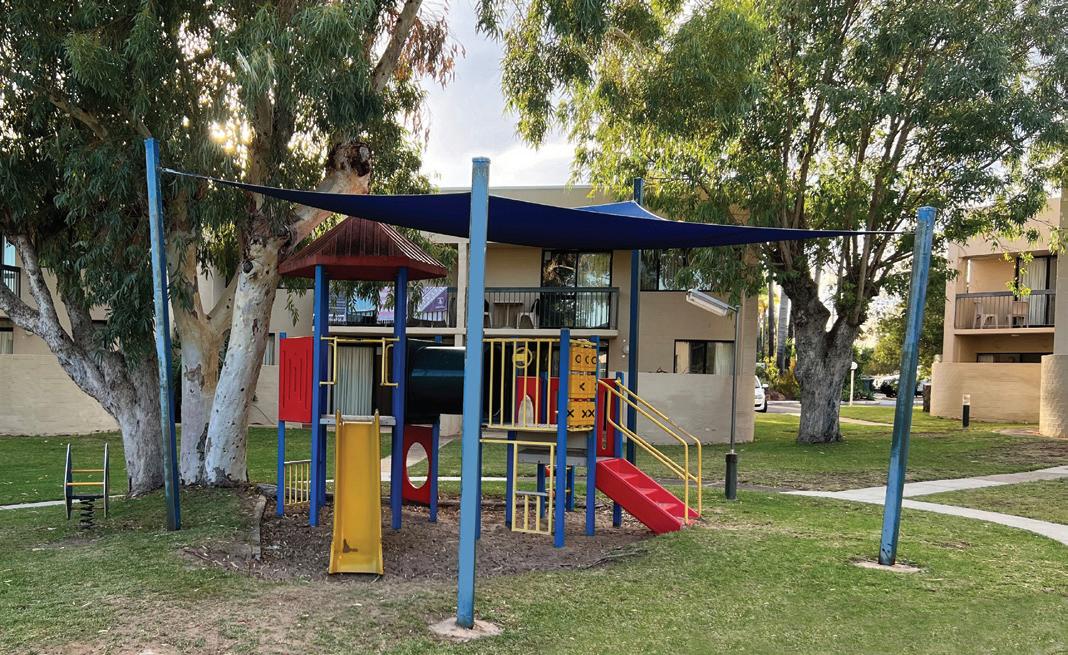
Since then, the ANF has made significant improvements to the resort, including replacing all electrical wiring, replacing the old evaporative air cooling systems with new reverse cycle air conditioning units in every apartment, upgrading lighting in common areas, repairing and upgrading existing facilities such as the barbeques, tennis courts and basketball court, installing free Wifi and smart TVs, replacing flimsy fly screen doors with security screen doors.
In addition to the other improvements made by the ANF, we also doubled the number of rubbish collections each week to ensure the resort remained clean and tidy for all guests. The ANF’s attention
to detail in every aspect of the resort’s management demonstrates our commitment to providing the best possible experience for any member who visits.
The ANF’s efforts were not limited to improving the resort’s facilities. After Cyclone Seroja, the ANF provided free accommodation for emergency workers, tradesmen, teachers, Western Power workers, nurses, and midwives, coordinating the efforts and ensuring a safe haven for those who needed it.
Despite the challenges of COVID, a devastating cyclone, a shortage of tradesmen and materials, the ANF has continued to work on improving the complex.

Firstly, the ANF has started work on heating the resort’s pool, providing guests with the opportunity to enjoy a comfortable swim no matter the weather conditions. This is a significant upgrade that will make the pool more accessible to guests year-round, regardless of the season.
Secondly, the ANF has also announced the installation of a gym on site. This will allow guests to stay active and maintain their fitness routines during their stay at the resort. The gym, which is expected to be opened in the coming months, will have with state-of-the-art equipment, providing members with a range of exercise options to suit their needs.
The ANF further upgrades to the wifi will provide even better access to streaming services and other online content for members, ensuring that they have a comfortable and enjoyable stay. By focusing on providing these modern amenities, the ANF is making the Kalbarri Holiday Units a truly modern and convenient holiday destination for its members.
The ANF Holiday units have been a fantastic asset and unique benefit for ANF members in WA, but it is now time for overdue refurbishments in Kalbarri. To address this, the ANF has embarked on a two-year program to upgrade the units. This program includes replacing all curtains and blinds, installing security fly screens on the windows, and completing outstanding renovations of bathrooms and kitchens to bring all units up to ANF standards. Additionally, the flooring will be replaced to enhance the overall look and feel of the units.
In the current economic climate, where interest rates and inflation are high, providing a low-cost and high-quality holiday option for ANF members is more important than ever. With these refurbishments, ANF members will continue to enjoy comfortable and enjoyable stays in Kalbarri at an affordable price.
With the pool heating project and gym installation underway, guests can look forward to an even better experience at the resort in the near future.
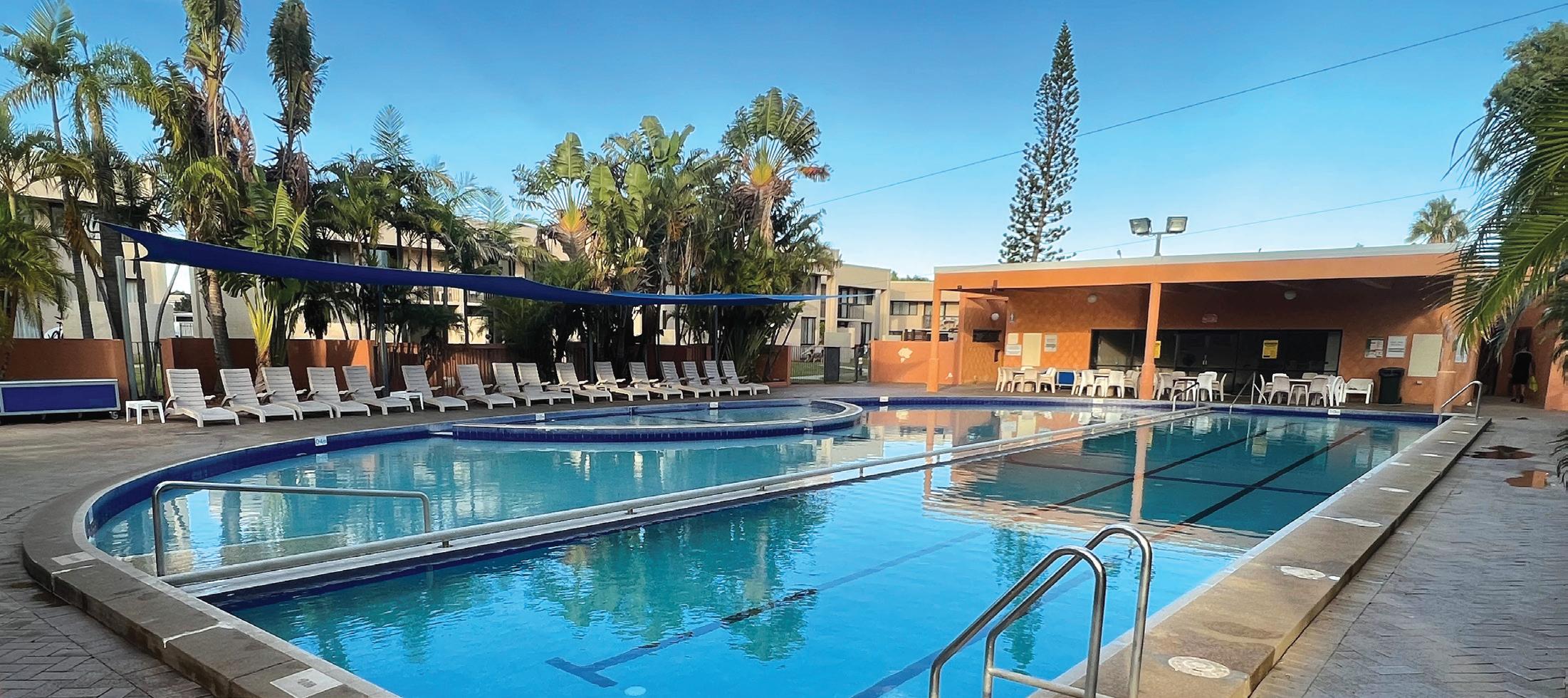
The improvements made over the past four years, have significantly enhanced the resort’s comfort and functionality while the ANF’s
focus on providing heavily discounted rates for members also ensures that the resort remains an affordable choice for those looking for a relaxing holiday.
Overall, the ANF’s efforts have paid off, as evidenced by the high level of support from unit owners at the last AGM. With the new heating project and gym installation, the ANF is taking the resort to the next level and ensuring that it remains a popular choice for ANF members for years to come.
The ANF is dedicated to providing a highquality experience for its members who stay in the Kalbarri units. Each time an individual unit is purchased, the ANF upgrades the furnishings and amenities to ensure it meets the desired standard. This includes replacing furniture such as lounges, mattresses, and double bunks, as well as fridges, televisions, vacuum cleaners, cooking utensils, and kitchenware. Additionally, front and rear door security screens have been installed to enhance safety and security for ANF members.
Despite recent supply chain issues, the ANF remains committed to ongoing improvements. In the next 12 months, renovations will be carried out on individual units, including updates to curtains, flooring, and completion of remaining kitchen renovations. These improvements will help ensure that ANF members and their families have a comfortable and even more enjoyable stay in the Kalbarri units.
Staff at the Saint Louis Zoo in the United States have found a new and much more secure home for one of their resident Andean bears following a number of escape attempts.
Ben, the four-year-old Andean bear, will be transferred to a zoo in Brownsville Texas. This facility has a moat rather than just a steel mesh outdoor enclosure to ensure Ben won’t be able to escape again.

Ben has made a grand total of two reasonably successful escapes, the first earlier this year, when staff at the zoo discovered Ben outside his habitat at about 8 am that morning. The team at the zoo were able to quickly tranquilise Ben and return him to his enclosure before visitors arrived.
The zoo released a statement saying there was no human error involved and that “it would appear that the very curious bear meddled with the steel mesh in just the right spot of the outdoor habitat, causing a cable to give way.”
A little over two weeks later Ben was at it again, this time while visitors were at the zoo. Guests were quickly escorted to safety while a team from the zoo secured Ben, a process that reportedly took about 50 minutes.
After this second escape it was decided that Ben should be moved to a more secure facility, and that he would be homed in the non-public section of the Saint Louis Zoo until his move to Texas.
The World Health Organization (WHO) is calling on its member states to implement national policies to reduce the amount of sodium people are consuming and to mitigate the harmful effects of excessive salt consumption.
The call for a reduction in salt consumption follows the release of the WHO’s Global report on sodium intake reduction, which shows that the world is off-track to achieve global targets for reducing sodium intake by 30 percent by 2025.
Sodium, a delicious and essential nutrient, can also increases the risk to our health when eaten in excess. According to the WHO sodium reduction policies could save an estimated 7 million lives globally by 2030.
WHO Director-General Dr Tedros Adhanom Ghebreyesus, said unhealthy diets are a leading cause of death and disease globally, and excessive sodium intake is one of the main culprits.
“This report shows that most countries are yet to adopt any mandatory sodium reduction policies, leaving their people at risk of heart attack, stroke, and other health problems,” Dr Ghebreyesus said.
The global average salt intake is estimated to be 10.8 grams per day, more than double the WHO recommendation of less than 5 grams of salt per day.
NASA’s Planetary Defence Coordination Office is tracking an asteroid named 2023 DW that is expected to pass close to Earth on 14 February 2046, Valentine’s Day.
According to NASA, the asteroid has a very small chance of impacting the Earth, which would most likely ruin everyone’s day, although more data will need to be collected before firmer predictions can be made.
NASA Asteroid Watch posted to Twitter that “orbit analysts will continue to monitor asteroid 2023 DW and update predictions as more data comes in.”

According to NASA, “often when new objects are first discovered, it takes several weeks of data to reduce the uncertainties and adequately predict their orbits years into the future,” so at this stage there is no
reason to cancel any plans you might have made for Valentine’s Day 2046.
2023 DW is approximately 50km in diameter and is currently 77,900,000 kilometres from Earth.
The International Council of Nurses (ICN) has a released a report on the worldwide shortage of nurses, stating the issue should be treated as a global health emergency.
The ICN report recounts the vital and often dangerous role nurses played during the pandemic and provides evidence from studies of nurses in over 25 countries, including Australia.
Co-authored by Adjunct Professor at the University of Technology Sydney James Buchan and ICN Chief Executive Officer Howard Catton, the report notes that health systems around the world will only start to recover when there is sufficient investment in a well-supported workforce.

“The current situation is a direct result of a lack of action and the absence of a long-term vision and a plan for the global nursing workforce,” Professor Buchan said.
“We need to see co-ordinated policy responses, both within countries and internationally, that will protect and support the global nursing workforce so they can be effective in their vital role of rebuilding our health systems.”
According to Mr Catton many nurses are leaving the profession, and many of those who remain are so concerned about patient safety and the wellbeing of colleagues they are taking industrial action.
“The worldwide shortage of nurses needs to be considered as a global health emergency and recovery from the current situation must to be a priority for governments everywhere,” Mr Catton said.
The ICN report cites more than 100 studies which show 40 to 80 percent of nurses experienced symptoms of psychological distress, as well as an increase in the number of nurses intending to leave the profession (to 20 percent or more) and an increase in annual hospital turnover rates (to 10 percent or more).

More progress is being called for to end tuberculosis (TB) as the infectious disease continues to be on track to overtake COVID-19 as a leading cause of death globally.
Figures released by the World Health Organisation (WHO) show that TB is still one the deadliest infectious diseases, killing about 1.6 million people annually. Worse still, the disease affects millions more every year, and the number of people becoming infected with TB, including drug resistant variations, is climbing.
According to the WHO the COVID-19 pandemic coupled with other ongoing has reversed years of progress made in the fight against TB. For the first time in nearly two decades, the WHO last year reported an increase in the number of people falling ill with TB and drug resistant TB, alongside an increase in deaths.
TB is an issue in Australia as well.
South Australian public health officials visited Aṉangu Pitjantjatjara Yankunytjatjara Lands earlier this year following an outbreak of TB in the region.
According to a statement from the South Australian Government, the South Australian Tuberculosis Service diagnosed “approximately” ten cases in the community which were linked as an outbreak.
Chief Public Health Officer, Professor Nicola Spurrier said Tuberculosis is not commonly seen in Australia but is treatable and preventable.
According to international aid and development organisation, Results International, more needs to be done, especially given the only vaccination for TB is more than a century old, and is less effective on adults, who account for the bulk of disease burden.
Results International Australia CEO Negaya Chorley said Tuberculosis is a prolific infectious disease that devastates the most vulnerable.
“TB could soon reclaim the title of leading cause of death worldwide from a single infectious agent,” Ms Chorley said.
“Yet, the disease is entirely preventable and curable. An effective new vaccine would save millions of lives and help fight antimicrobial resistance, while also offering a substantial return on investment.”
This is a sentiment echoed by WHO Director-General Dr Tedros Adhanom Ghebreyesus.
“TB is preventable, treatable and curable, and yet this ancient scourge that has afflicted humanity for millennia continues to cause suffering and death for millions every year,” Dr Ghebreyesus said.
“WHO is committed to supporting countries to step up their response, by expanding access to services to prevent, detect and treat TB as part of their journey towards universal health coverage, and to strengthen their defences against epidemics and pandemics.”
A new campaign is underway in Australia and across the world to double the global consumption of beans by 2028. The campaign, Beans is How, promotes the health and environmental benefits of beans, as well as legumes, peas and pulses.
The Grains and Legumes Nutrition Council (GLNC), a peak authority on the nutrition and health benefits of grains and legumes in Australia, recently announced its support for the campaign.

GLNC General Manager Kathy La Macchia said the organisation will partner with Beans is How to promote the benefits of beans as part of a healthy and sustainable diet.
“Beans are a great source of protein, fibre, and other important nutrients, and they play an important role in reducing our environmental footprint,” Ms La Macchia said.
Paul Newnham, Chief Bean Officer and Executive Director of the SDG2 Advocacy Hub driving the campaign, was thrilled to have the support of the GLNC in their mission to transform the perception of beans.
“Globally, we are challenged by an increased cost of living, climate change and an increase in diet-related diseases while others suffer from malnutrition, ”Mr Newnham said.
“Beans is How we can inspire more people to make healthy and sustainable food choices that benefit both themselves and the planet.”
A British man has pled guilty to criminal damage and two counts of theft, having been caught by West Mercia Police after stealing almost 200,000 Creme Eggs.
Joby Pool, 32, appeared at Kidderminster Magistrates’ Court and pled guilty to the chocolate related crimes before being remanded in custody.
The egg heist took place on earlier this year when the 200,000 Creme Eggs, thought to have street value of around £40,000, were stolen from a unit in Stafford Park in Telford.
Shortly after the theft West Mercia Police stopped a vehicle heading northbound on the M42 and recovered the stolen goods. Along with the Creme Eggs, Police said a number of other chocolate varieties were also stolen. Mr Pool was arrested on suspicion of theft and later charged.
Mr Pool is not at this stage believed to have any connection with the Easter Bunny.
Read this article and complete the quiz to earn 0.5 iFolio hour
Brand names: Keytruda1
Drug class: antineoplastics1
Pembrolizumab is a monoclonal antibody directed against the programmed death 1 (PD-1) receptor.1,2 PD-1 is an immunecheckpoint receptor that limits the activity of T lymphocytes in peripheral tissues to help prevent the immune system from attacking itself.2,3 Certain types of tumours have the potential to evade the immune response by limiting the activity of T lymphocytes on tumour cells. 1,3
Pembrolizumab inhibits the PD-1 receptor from binding to its ligands (PD-L1 and PD-L2) on tumour cells.1,2 By inhibiting the PD-1 receptor from binding to its ligands, pembrolizumab reactivates tumour-specific cytotoxic T lymphocytes in the tumour microenvironment and antitumour immunity.1,2
Pembrolizumab is administered by intravenous infusion over 30 minutes. 1
Indications for pembrolizumab are: 1,2
• Unresectable or metastatic melanoma
• Metastatic non-squamous non-small cell lung cancer
• Metastatic or unresectable recurrent head and neck squamous cell cancer
• Relapsed or refractory classical Hodgkin Lymphoma
• Primary mediastinal B-cell lymphoma
• Locally advanced or metastatic urothelial carcinoma
• Unresectable or metastatic colorectal cancer
• Advanced endometrial carcinoma
• Advanced renal cell carcinoma.
There are no known contraindications for pembrolizumab.2,3
However, pembrolizumab should be used cautiously for patients with a history of adverse reactions from ipilimumab. 1
Systemic corticosteroids and immunosuppressants may interfere with the pharmacodynamic activity and efficacy of pembrolizumab and should be avoided prior to starting pembrolizumab therapy.2 Systemic corticosteroids and immunosuppressants may be used after commencing pembrolizumab therapy to treat immune-mediated adverse reactions.2
While no formal pharmacokinetic drug interaction studies have been conducted, as pembrolizumab is cleared from the circulation through catabolism, no metabolic drug interactions are expected. 2
For adults, the recommended dose of pembrolizumab is 200mg every three weeks.2
For children, the recommended dose is 2mg/kg (up to a maximum of 200mg) every three weeks.2
Pembrolizumab should be used with caution in patients with autoimmune disease.1,2 Patients with autoimmune disease were excluded from clinical trials.1,2
Pembrolizumab is not recommended for use during pregnancy. 2,4 It is expected to cause increased incidence of human fetal malformations, abortion, and stillbirth. 2,4
Pembrolizumab is not recommended for use while breastfeeding due to the potential risk of severe immune-mediated adverse reactions in the infant. 2,4
Common adverse effects associated with pembrolizumab include nausea, constipation, decreased appetite, headache, cough, dyspnoea, peripheral oedema, increased blood glucose, and anaemia.1
Pembrolizumab is also associated with immune-mediated reactions including type 1 diabetes, hypothyroidism, hyperthyroidism, inflammation of the pituitary gland, gastrointestinal effects, pneumonitis, increased aminotransferases, hepatitis, nephritis, arthralgia, myositis, uveitis, and skin reactions such as itching, rash, and vitiligo.1 Most immune-mediated reactions occur during treatment, but they may occur weeks or months later.1,2
Administration of pembrolizumab may be associated with infusion-related reactions such as itching, flushing, rash, fever, chills, rigors, wheezing, and hypotension. 1
1. Pembrolizumab. 2020 [cited 2021 Feb 17]. In: Australian Medicines Handbook [Internet]. Adelaide (Australia): Australian Medicines Handbook. Available from: https:// amhonline-amh-net-au/chapters/immunomodulators-antineoplastics/non-cytotoxic-antineoplastics/antineoplastic-antibodies/ pembrolizumab
2. Keytruda. 2020 [cited 2021 Feb 17]. In: MIMS Online database [Internet]. North Sydney (Australia): MIMS Australia. Available from: https://www.mimsonline.com. au/ Search/FullPI.aspx?ModuleName=Product%20Info&searchKeyword=pembrolizumab&PreviousPage=~/Search/QuickSearch. aspx&SearchType=&ID=73730002_2
3. Flynn JP, Gerriets V. Pembrolizumab. 2020 [cited 2020 Nov 14]. In: StatPearls [Internet]. Treasure Island (FL): StatPearls Publishing LLC. Available from: https://www.ncbi.nlm. nih.gov/books/NBK546616
4. Pembrolizumab. 2019 [cited 2021 Feb 18]. In: Pregnancy and Breastfeeding Medicines Guide [Internet]. Melbourne (Australia): The Royal Women’s Hospital. Available from: https://thewomenspbmg.org.au/ medicines/ pembrolizumab
Read this article and complete the quiz to earn 0.5 iFolio hour
Brand name: Prednisone – Panafcortelone, Predsolone, Solone1,2 Prednisolone – Panafcort, Predsone, Sone1,2 Hydrocortisone – Solu-Cortef1,2
Drug class: corticosteroids2
Corticosteroids regulate gene expression by reacting with receptor proteins in cell cytoplasm, affecting gene transcription and causing the inhibition of gene expression and translation.2,3 This leads to decreased proinflammatory cytokines and chemokines.3
Corticosteroids may have glucocorticoid effects (gluconeogenesis, proteolysis, lipolysis, suppression of inflammation and immune responses) or mineralocorticoid effects (hypertension, salt and water retention, potassium loss).2
Prednisone and prednisolone are synthetic corticosteroids with predominantly glucocorticoid effects.3 Prednisone is the prodrug of prednisolone, it must be converted to the active metabolite prednisolone to have an anti-inflammatory or immunosuppressive effect.2
Hydrocortisone is a synthetic corticosteroid with a combination of glucocorticoid and mineralocorticoid effects.2
Corticosteroids are a symptomatic treatment; they are never curative.3
Systemic corticosteroids for the treatment of chronic obstructive pulmonary disease (COPD) exacerbations are generally administered orally.1,5
If oral medication is not tolerated, systemic corticosteroids may be administered intravenously.1
Systemic corticosteroids are indicated for the treatment of COPD exacerbations.4,5 Short courses may reduce the severity of exacerbations, shorten recovery time, and decrease the risk of relapse. 5,6
Note: systemic corticosteroids are indicated in a number of other conditions, such as allergic dermatitis, acute asthma, gout, acquired haemolytic anaemia, ulcerative colitis, rheumatoid arthritis, and rheumatic fever.4
Systemic corticosteroids are contraindicated in patients with:2,4
• Hypersensitivity to corticosteroids
• Uncontrolled infection.
Corticosteroids have a number of clinically meaningful drug interactions.
Antiretrovirals, including atazanavir, darunavir, elvitegravir with cobicistat, and ritonavir, may increase the concentration of corticosteroids which may result in adrenal suppression.7 If antiretrovirals and corticosteroids are used concurrently the patient should be carefully monitored and the corticosteroid stopped or the dose reduced if necessary.7
Hepatic enzyme inducers, such as rifampicin, phenytoin, and phenobarbital, increase the metabolism of corticosteroids, decreasing their clinical effect.7 If hepatic enzyme inducers and corticosteroids are used concurrently the clinical effects should be monitored, and the corticosteroid dose increased if necessary.7
Mifepristone has anti-glucocorticoid effects that may reduce the clinical effect of corticosteroids.7 Concurrent use of mifepristone and corticosteroids should be avoided if possible.7 If they are used concurrently, consideration should be given to increasing the corticosteroid dose with carefully monitoring.7
Concurrent use of oral corticosteroids and nonsteroidal anti-inflammatory drugs (NSAIDs) increases the risk of gastric ulceration.7 Concurrent use should be avoided if possible.7 If they are used concurrently, the lowest effective dose of the NSAID should be used for shortest period. 7 Corticosteroids may increase warfarin’s anticoagulant effect, increasing the risk of bleeding.7 If warfarin and corticosteroids are used concurrently the patient’s international normalised ratio (INR) should be monitored and the warfarin dose reduced if necessary.7
If the patient can tolerate oral medication, the dose of prednisone/prednisolone is 30-50mg once daily for five days.1
If oral medication is not tolerated, 50mg of hydrocortisone should be administered intravenously 6-hourly until oral administration is tolerated.1 When oral administration is tolerated, the patient should be switched to oral therapy and continued for a total of five days of therapy (intravenous and oral therapy).1
Short courses, less than 14 days, of prednisone/ prednisolone can be stopped abruptly without tapering.1,6
Hepatic impairment
Prednisone/prednisolone should be used with caution in patients with hepatic impairment. 4
Prednisone/prednisolone and hydrocortisone are safe to use during pregnancy.7,8,9 If they are used during pregnancy, it should be at the lowest effective dose for the shortest possible time, and maternal and fetal wellbeing should be closely monitored.2,9
Prednisone/prednisolone and hydrocortisone are safe to use while breastfeeding.7,8,9 If prednisone/ prednisolone is used while breastfeeding it should be at the lowest effective dose for the shortest possible time and, if possible, breastfeeding should be avoided for three to four hours following the prednisone/prednisolone dose.9
Adverse effects of corticosteroid therapy are dependent on dose and duration of the treatment.2 Short courses of corticosteroids generally cause fewer and less severe adverse effects.2
Common adverse effects associated with corticosteroids include infection, salt and water retention, oedema, hypertension, hypokalaemia, hyperglycaemia, diabetes, dyslipidaemia, osteoporosis, fractures, increased appetite, dyspepsia, skin atrophy, bruising, facial flushing, hirsutism, myopathy, muscle weakness, fat redistribution, adrenal suppression, weight gain, menstrual irregularity, and posterior subcapsular cataracts.2 Common adverse effects may also include psychiatric effects, such as hypomania, depression, euphoria, and disturbances of cognition, sleep, mood, and behaviour.2
Corticosteroids may infrequently be associated with osteonecrosis, ocular hypertension, and glaucoma.2
Rarely, corticosteroids are associated with peptic ulceration, hypersensitivity reactions, tendon rupture, central serous chorioretinopathy, and fat deposition around spinal cord.2
1. Chronic obstructive pulmonary disease (COPD) exacerbations. 2020 [cited 2021 Feb 14]. In: eTG Complete [Internet]. Melbourne (Australia): Therapeutic Guidelines Limited. Available from: https://tgldcdp-tg-org-au/ viewTopic?topicfile=chronic-obstructive-pulmonary-disease-exacerbations&guidelineName=Respiratory#toc_ d1e313
2. Corticosteroids. 2020 [cited 2021 Feb 16]. In: Australian Medicines Handbook [Internet]. Adelaide (Australia): Australian Medicines Handbook. Available from: https:// amhonline.amh.net.au/chapters/immunomodulators-antineoplastics/immunosuppressants/corticosteroids
3. Hodgens A, Sharman T. Corticosteroids. In: StatPearls [Internet]. Treasure Island (FL): StatPearls Publishing LLC; 2020 [cited 2021 Feb 16]. Available from: https://www. ncbi.nlm.nih.gov/books/NBK554612
4. Panafcort. 2020 [cited 2021 Feb 16]. In: MIMS Online database [Internet]. North Sydney (Australia): MIMS Australia. Available from: https://www.mimsonline.com.au/ Search/AbbrPI.aspx?ModuleName=Product%20Info&searchKeyword=Prednisone&PreviousPage=~/Search/ QuickSearch.aspx&SearchType=&ID=6880001_2
5. Chronic obstructive pulmonary disease. 2020 [cited 2021 Feb 16]. In: Australian Medicines Handbook [Internet]. Adelaide (Australia): Australian Medicines Handbook. Available from: https://amhonline.amh.net.au/ chapters/respiratory-drugs/drugs-asthma-chronic-obstructive-pulmonary-disease/chronic-obstructive-pulmonary-disease
6. Lung Foundation Australia. The COPD-X Plan: Australian and New Zealand Guidelines for the Management of Chronic Obstructive Pulmonary Disease 2020 [Internet]. Milton (Australia): Lung Foundation Australia; 2020 [cited 2021 Feb 15]. Available from: https://copdx.org.au/ wp-content/uploads/2021/02/COPDX-V2.62-June_ Oct-2020-PUBLISHED.pdf
7. Drug use in pregnancy and breastfeeding. 2020 [cited 2021 Feb 16]. In: eTG Complete [Internet]. Melbourne (Australia): Therapeutic Guidelines Limited. Available from: https://tgldcdp-tg-org-au/ quicklinks?type=Pregnancy%20and%20breastfeeding&bf=5a58609.htm
8. Hydrocortisone. 2020 [cited 2021 Feb 16]. In: Pregnancy and Breastfeeding Medicines Guide [Internet]. Melbourne (Australia): The Royal Women’s Hospital. Available from: https://thewomenspbmg.org.au/ medicines/ hydrocortisone
9. Prednisone/Prednisolone. 2020 [cited 2021 Feb 16]. In: Pregnancy and Breastfeeding Medicines Guide [Internet]. Melbourne (Australia): The Royal Women’s Hospital. Available from: https://thewomenspbmg.org.au/ medicines/prednisoneprednisolone
The ANF offers informative talks on topics relevant to contemporary nursing and midwifery, all for free.


Places are available on a range of topics: Coroners Court: Learn more about coroners' investigations including discussions on the role of the coroner, the inquest process, evidence gathering, being a witness, making statements and other legal considerations surrounding coroners' reports.
Documentation: A handy refresher on the importance of proper documentation, best practices for record-keeping, legal requirements for documentation and how to maintain accurate and comprehensive records.
Social Media: Take part in discussions around potential legal issues that can arise from its use including privacy concerns, defamation, intellectual property infringement, professional boundaries and ethical considerations when using all types of online media platforms.
Discrimination: This talk covers the legal framework surrounding discrimination, including laws, regulations and case precedents, with reference to the various forms of discrimination, such as gender, race, age, or disability and provide guidance on how to prevent and address such issues in professional settings.
Defamation: Defamation involves making false statements that harm someone's reputation. We explain the elements of a defamation claim, how to minimize the risk of defamation in the context of the workplace, defences against defamation and the potential consequences of defamatory statements on your registration and your wallet.
Workers’ Compensation: This session covers the essentials that all members must know about the Workers’ Compensation process and how to make it work for you rather than your employer if you are injured at work.
ANF Job Rep Training 1: This important information is useful for all members, not just Job Reps, and covers the process of resolving group issues at your workplace.